An Overview of MAE Company
VerifiedAdded on 2022/02/19
|19
|4392
|24
AI Summary
Mid American Energy Company (MAE) is a US-based energy company that delivers electricity, natural gas, and wind energy to clients in Iowa, Illinois, South Dakota, and Nebraska. Berkshire Hathaway Energy is a subsidiary of Berkshire Hathaway(Bloomberg, 2019). Because the cost of wind-generated power has decreased, demand for traditional energy replacements such as coal and other fossil fuels has decreased.
Contribute Materials
Your contribution can guide someone’s learning journey. Share your
documents today.
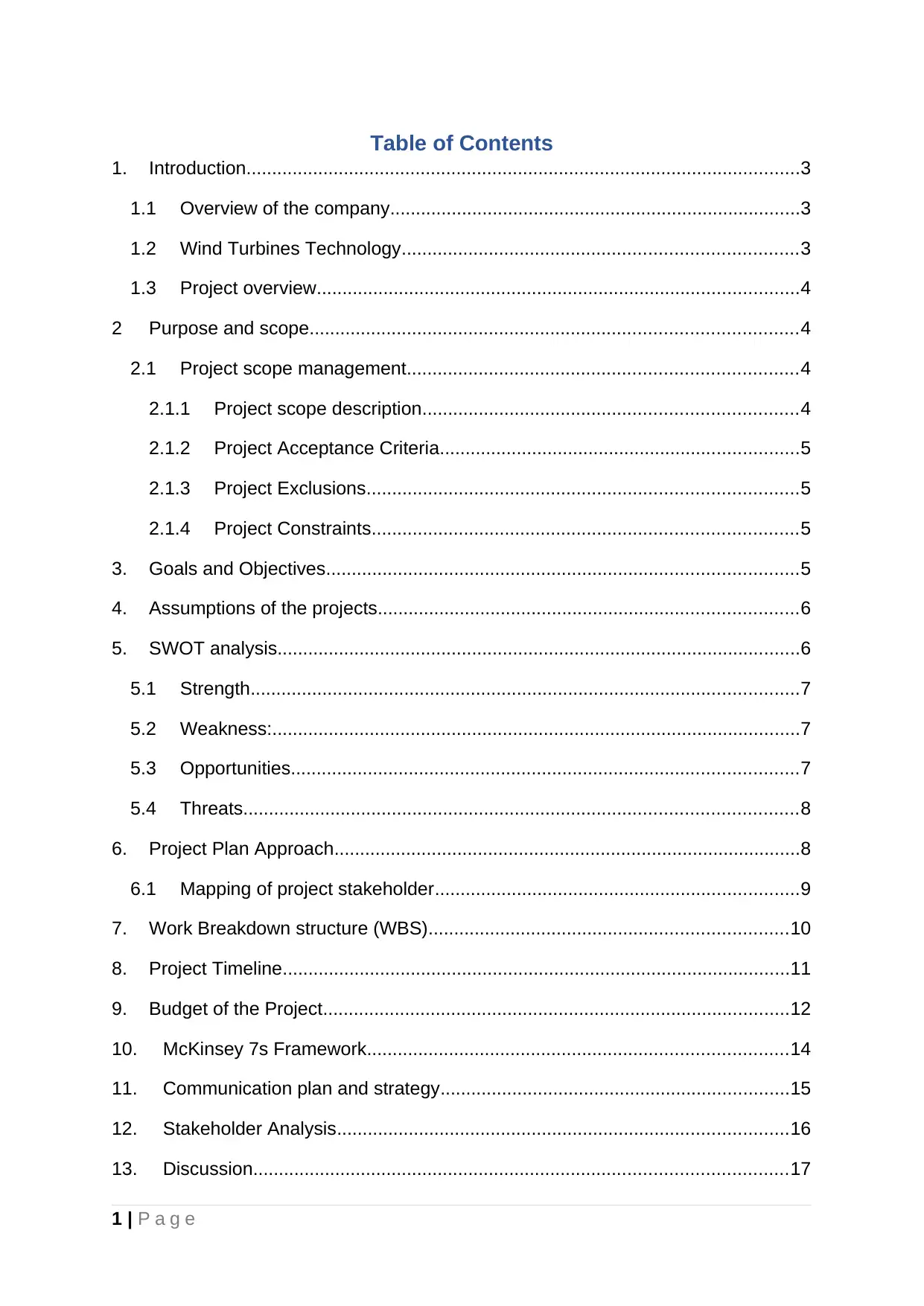
Table of Contents
1. Introduction............................................................................................................3
1.1 Overview of the company................................................................................3
1.2 Wind Turbines Technology.............................................................................3
1.3 Project overview..............................................................................................4
2 Purpose and scope...............................................................................................4
2.1 Project scope management............................................................................4
2.1.1 Project scope description.........................................................................4
2.1.2 Project Acceptance Criteria......................................................................5
2.1.3 Project Exclusions....................................................................................5
2.1.4 Project Constraints...................................................................................5
3. Goals and Objectives............................................................................................5
4. Assumptions of the projects..................................................................................6
5. SWOT analysis......................................................................................................6
5.1 Strength...........................................................................................................7
5.2 Weakness:.......................................................................................................7
5.3 Opportunities...................................................................................................7
5.4 Threats............................................................................................................8
6. Project Plan Approach...........................................................................................8
6.1 Mapping of project stakeholder.......................................................................9
7. Work Breakdown structure (WBS)......................................................................10
8. Project Timeline...................................................................................................11
9. Budget of the Project...........................................................................................12
10. McKinsey 7s Framework..................................................................................14
11. Communication plan and strategy....................................................................15
12. Stakeholder Analysis........................................................................................16
13. Discussion........................................................................................................17
1 | P a g e
1. Introduction............................................................................................................3
1.1 Overview of the company................................................................................3
1.2 Wind Turbines Technology.............................................................................3
1.3 Project overview..............................................................................................4
2 Purpose and scope...............................................................................................4
2.1 Project scope management............................................................................4
2.1.1 Project scope description.........................................................................4
2.1.2 Project Acceptance Criteria......................................................................5
2.1.3 Project Exclusions....................................................................................5
2.1.4 Project Constraints...................................................................................5
3. Goals and Objectives............................................................................................5
4. Assumptions of the projects..................................................................................6
5. SWOT analysis......................................................................................................6
5.1 Strength...........................................................................................................7
5.2 Weakness:.......................................................................................................7
5.3 Opportunities...................................................................................................7
5.4 Threats............................................................................................................8
6. Project Plan Approach...........................................................................................8
6.1 Mapping of project stakeholder.......................................................................9
7. Work Breakdown structure (WBS)......................................................................10
8. Project Timeline...................................................................................................11
9. Budget of the Project...........................................................................................12
10. McKinsey 7s Framework..................................................................................14
11. Communication plan and strategy....................................................................15
12. Stakeholder Analysis........................................................................................16
13. Discussion........................................................................................................17
1 | P a g e
Secure Best Marks with AI Grader
Need help grading? Try our AI Grader for instant feedback on your assignments.
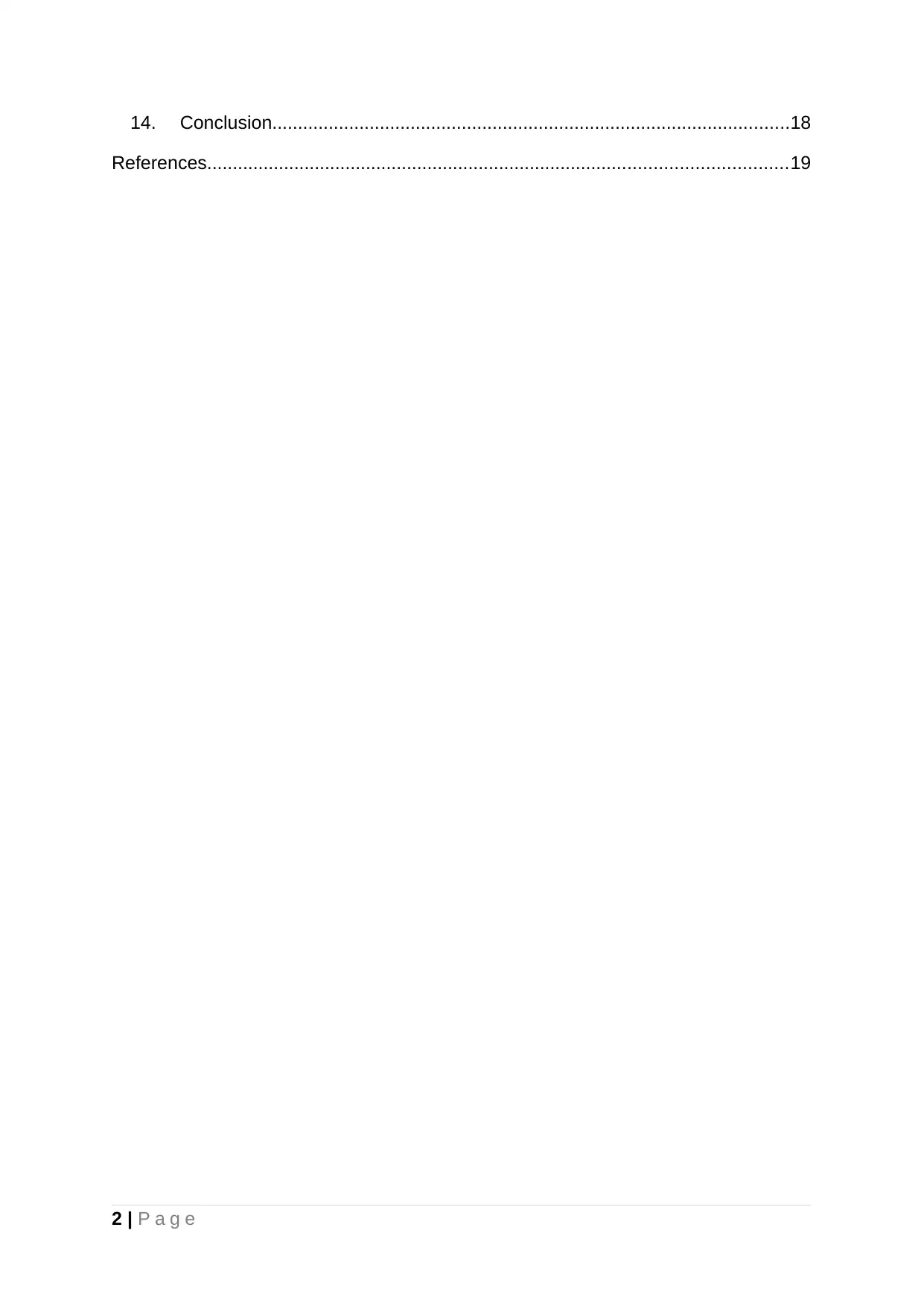
14. Conclusion.....................................................................................................18
References.................................................................................................................19
2 | P a g e
References.................................................................................................................19
2 | P a g e
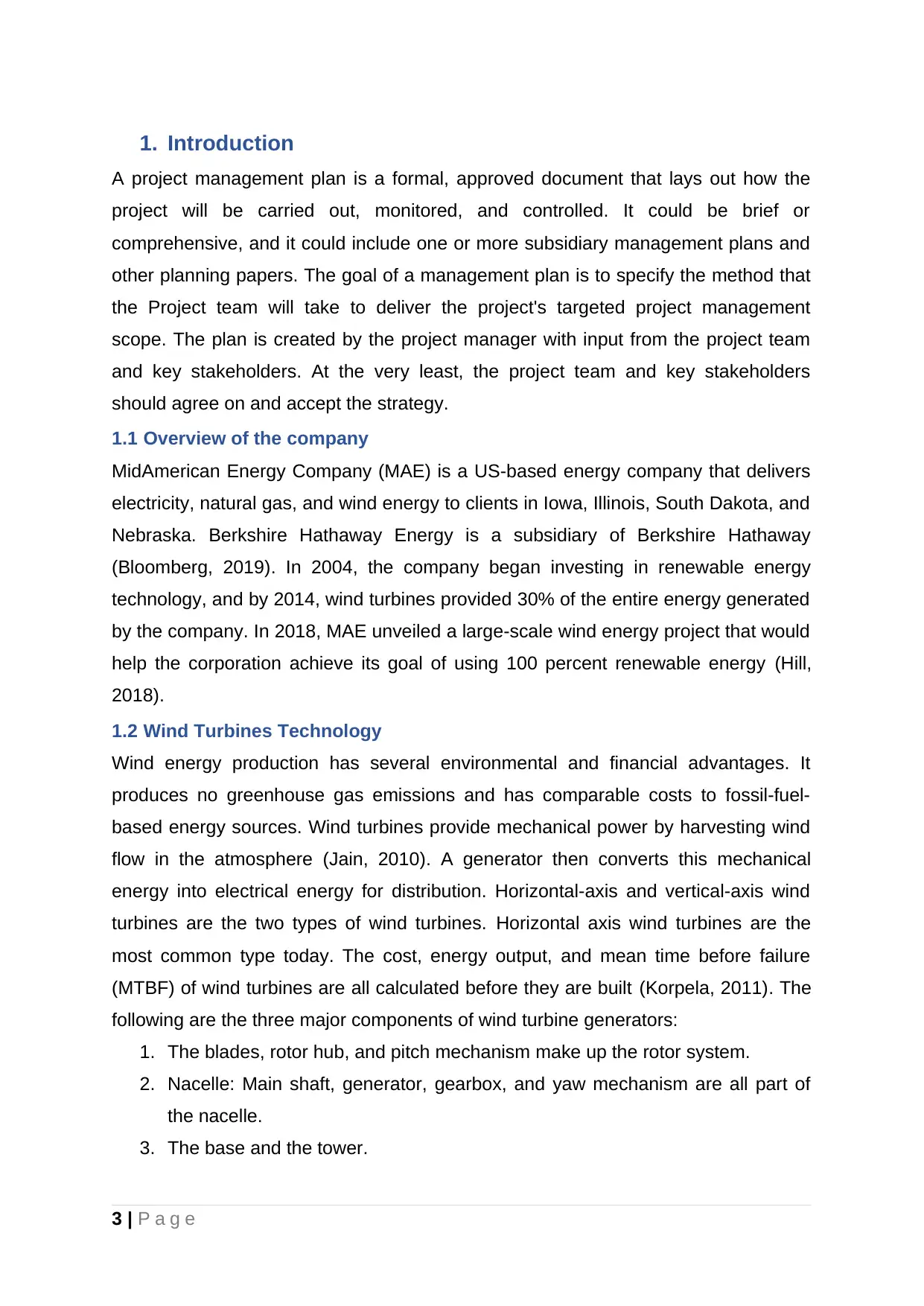
1. Introduction
A project management plan is a formal, approved document that lays out how the
project will be carried out, monitored, and controlled. It could be brief or
comprehensive, and it could include one or more subsidiary management plans and
other planning papers. The goal of a management plan is to specify the method that
the Project team will take to deliver the project's targeted project management
scope. The plan is created by the project manager with input from the project team
and key stakeholders. At the very least, the project team and key stakeholders
should agree on and accept the strategy.
1.1 Overview of the company
MidAmerican Energy Company (MAE) is a US-based energy company that delivers
electricity, natural gas, and wind energy to clients in Iowa, Illinois, South Dakota, and
Nebraska. Berkshire Hathaway Energy is a subsidiary of Berkshire Hathaway
(Bloomberg, 2019). In 2004, the company began investing in renewable energy
technology, and by 2014, wind turbines provided 30% of the entire energy generated
by the company. In 2018, MAE unveiled a large-scale wind energy project that would
help the corporation achieve its goal of using 100 percent renewable energy (Hill,
2018).
1.2 Wind Turbines Technology
Wind energy production has several environmental and financial advantages. It
produces no greenhouse gas emissions and has comparable costs to fossil-fuel-
based energy sources. Wind turbines provide mechanical power by harvesting wind
flow in the atmosphere (Jain, 2010). A generator then converts this mechanical
energy into electrical energy for distribution. Horizontal-axis and vertical-axis wind
turbines are the two types of wind turbines. Horizontal axis wind turbines are the
most common type today. The cost, energy output, and mean time before failure
(MTBF) of wind turbines are all calculated before they are built (Korpela, 2011). The
following are the three major components of wind turbine generators:
1. The blades, rotor hub, and pitch mechanism make up the rotor system.
2. Nacelle: Main shaft, generator, gearbox, and yaw mechanism are all part of
the nacelle.
3. The base and the tower.
3 | P a g e
A project management plan is a formal, approved document that lays out how the
project will be carried out, monitored, and controlled. It could be brief or
comprehensive, and it could include one or more subsidiary management plans and
other planning papers. The goal of a management plan is to specify the method that
the Project team will take to deliver the project's targeted project management
scope. The plan is created by the project manager with input from the project team
and key stakeholders. At the very least, the project team and key stakeholders
should agree on and accept the strategy.
1.1 Overview of the company
MidAmerican Energy Company (MAE) is a US-based energy company that delivers
electricity, natural gas, and wind energy to clients in Iowa, Illinois, South Dakota, and
Nebraska. Berkshire Hathaway Energy is a subsidiary of Berkshire Hathaway
(Bloomberg, 2019). In 2004, the company began investing in renewable energy
technology, and by 2014, wind turbines provided 30% of the entire energy generated
by the company. In 2018, MAE unveiled a large-scale wind energy project that would
help the corporation achieve its goal of using 100 percent renewable energy (Hill,
2018).
1.2 Wind Turbines Technology
Wind energy production has several environmental and financial advantages. It
produces no greenhouse gas emissions and has comparable costs to fossil-fuel-
based energy sources. Wind turbines provide mechanical power by harvesting wind
flow in the atmosphere (Jain, 2010). A generator then converts this mechanical
energy into electrical energy for distribution. Horizontal-axis and vertical-axis wind
turbines are the two types of wind turbines. Horizontal axis wind turbines are the
most common type today. The cost, energy output, and mean time before failure
(MTBF) of wind turbines are all calculated before they are built (Korpela, 2011). The
following are the three major components of wind turbine generators:
1. The blades, rotor hub, and pitch mechanism make up the rotor system.
2. Nacelle: Main shaft, generator, gearbox, and yaw mechanism are all part of
the nacelle.
3. The base and the tower.
3 | P a g e
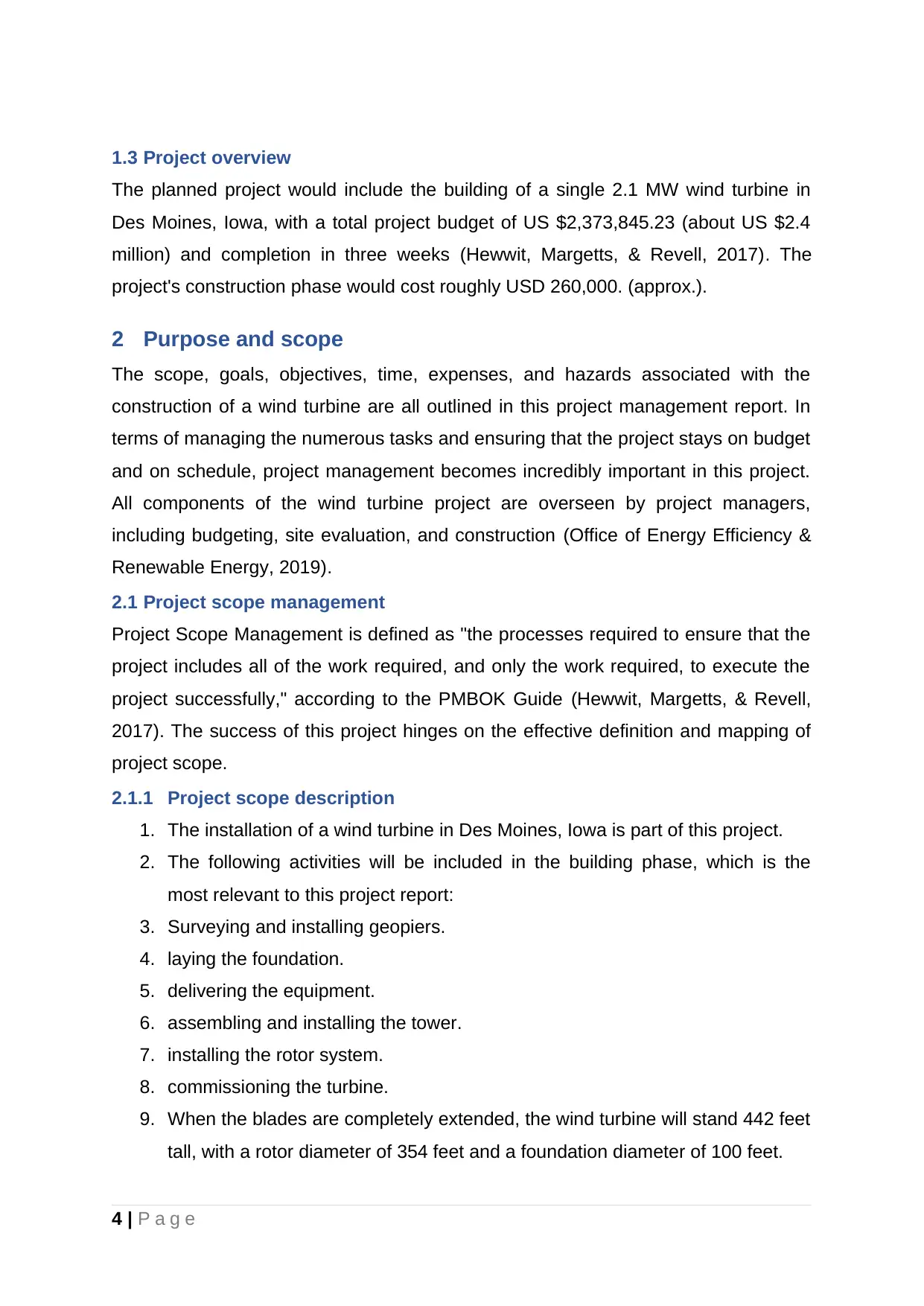
1.3 Project overview
The planned project would include the building of a single 2.1 MW wind turbine in
Des Moines, Iowa, with a total project budget of US $2,373,845.23 (about US $2.4
million) and completion in three weeks (Hewwit, Margetts, & Revell, 2017). The
project's construction phase would cost roughly USD 260,000. (approx.).
2 Purpose and scope
The scope, goals, objectives, time, expenses, and hazards associated with the
construction of a wind turbine are all outlined in this project management report. In
terms of managing the numerous tasks and ensuring that the project stays on budget
and on schedule, project management becomes incredibly important in this project.
All components of the wind turbine project are overseen by project managers,
including budgeting, site evaluation, and construction (Office of Energy Efficiency &
Renewable Energy, 2019).
2.1 Project scope management
Project Scope Management is defined as "the processes required to ensure that the
project includes all of the work required, and only the work required, to execute the
project successfully," according to the PMBOK Guide (Hewwit, Margetts, & Revell,
2017). The success of this project hinges on the effective definition and mapping of
project scope.
2.1.1 Project scope description
1. The installation of a wind turbine in Des Moines, Iowa is part of this project.
2. The following activities will be included in the building phase, which is the
most relevant to this project report:
3. Surveying and installing geopiers.
4. laying the foundation.
5. delivering the equipment.
6. assembling and installing the tower.
7. installing the rotor system.
8. commissioning the turbine.
9. When the blades are completely extended, the wind turbine will stand 442 feet
tall, with a rotor diameter of 354 feet and a foundation diameter of 100 feet.
4 | P a g e
The planned project would include the building of a single 2.1 MW wind turbine in
Des Moines, Iowa, with a total project budget of US $2,373,845.23 (about US $2.4
million) and completion in three weeks (Hewwit, Margetts, & Revell, 2017). The
project's construction phase would cost roughly USD 260,000. (approx.).
2 Purpose and scope
The scope, goals, objectives, time, expenses, and hazards associated with the
construction of a wind turbine are all outlined in this project management report. In
terms of managing the numerous tasks and ensuring that the project stays on budget
and on schedule, project management becomes incredibly important in this project.
All components of the wind turbine project are overseen by project managers,
including budgeting, site evaluation, and construction (Office of Energy Efficiency &
Renewable Energy, 2019).
2.1 Project scope management
Project Scope Management is defined as "the processes required to ensure that the
project includes all of the work required, and only the work required, to execute the
project successfully," according to the PMBOK Guide (Hewwit, Margetts, & Revell,
2017). The success of this project hinges on the effective definition and mapping of
project scope.
2.1.1 Project scope description
1. The installation of a wind turbine in Des Moines, Iowa is part of this project.
2. The following activities will be included in the building phase, which is the
most relevant to this project report:
3. Surveying and installing geopiers.
4. laying the foundation.
5. delivering the equipment.
6. assembling and installing the tower.
7. installing the rotor system.
8. commissioning the turbine.
9. When the blades are completely extended, the wind turbine will stand 442 feet
tall, with a rotor diameter of 354 feet and a foundation diameter of 100 feet.
4 | P a g e
Secure Best Marks with AI Grader
Need help grading? Try our AI Grader for instant feedback on your assignments.
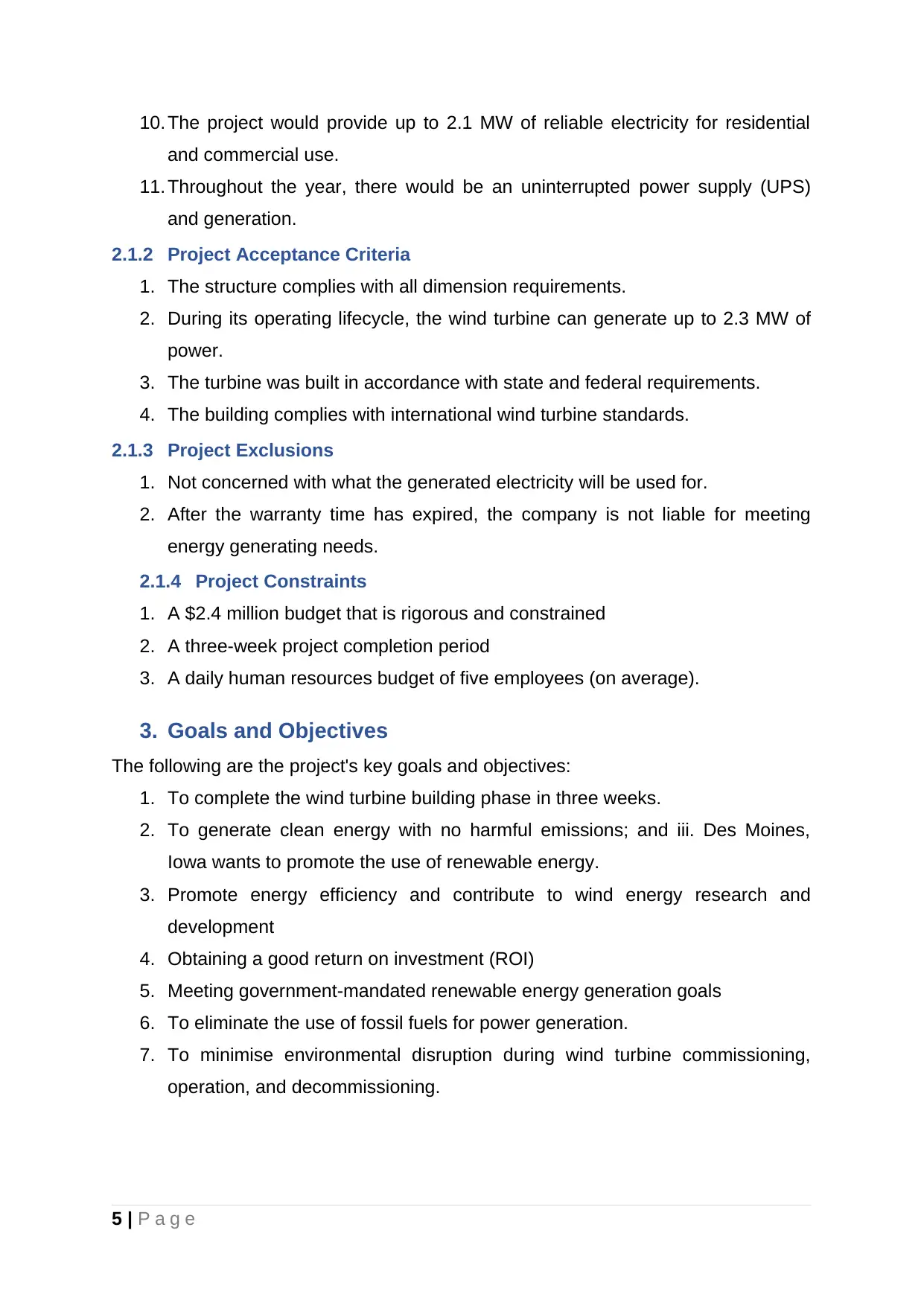
10. The project would provide up to 2.1 MW of reliable electricity for residential
and commercial use.
11. Throughout the year, there would be an uninterrupted power supply (UPS)
and generation.
2.1.2 Project Acceptance Criteria
1. The structure complies with all dimension requirements.
2. During its operating lifecycle, the wind turbine can generate up to 2.3 MW of
power.
3. The turbine was built in accordance with state and federal requirements.
4. The building complies with international wind turbine standards.
2.1.3 Project Exclusions
1. Not concerned with what the generated electricity will be used for.
2. After the warranty time has expired, the company is not liable for meeting
energy generating needs.
2.1.4 Project Constraints
1. A $2.4 million budget that is rigorous and constrained
2. A three-week project completion period
3. A daily human resources budget of five employees (on average).
3. Goals and Objectives
The following are the project's key goals and objectives:
1. To complete the wind turbine building phase in three weeks.
2. To generate clean energy with no harmful emissions; and iii. Des Moines,
Iowa wants to promote the use of renewable energy.
3. Promote energy efficiency and contribute to wind energy research and
development
4. Obtaining a good return on investment (ROI)
5. Meeting government-mandated renewable energy generation goals
6. To eliminate the use of fossil fuels for power generation.
7. To minimise environmental disruption during wind turbine commissioning,
operation, and decommissioning.
5 | P a g e
and commercial use.
11. Throughout the year, there would be an uninterrupted power supply (UPS)
and generation.
2.1.2 Project Acceptance Criteria
1. The structure complies with all dimension requirements.
2. During its operating lifecycle, the wind turbine can generate up to 2.3 MW of
power.
3. The turbine was built in accordance with state and federal requirements.
4. The building complies with international wind turbine standards.
2.1.3 Project Exclusions
1. Not concerned with what the generated electricity will be used for.
2. After the warranty time has expired, the company is not liable for meeting
energy generating needs.
2.1.4 Project Constraints
1. A $2.4 million budget that is rigorous and constrained
2. A three-week project completion period
3. A daily human resources budget of five employees (on average).
3. Goals and Objectives
The following are the project's key goals and objectives:
1. To complete the wind turbine building phase in three weeks.
2. To generate clean energy with no harmful emissions; and iii. Des Moines,
Iowa wants to promote the use of renewable energy.
3. Promote energy efficiency and contribute to wind energy research and
development
4. Obtaining a good return on investment (ROI)
5. Meeting government-mandated renewable energy generation goals
6. To eliminate the use of fossil fuels for power generation.
7. To minimise environmental disruption during wind turbine commissioning,
operation, and decommissioning.
5 | P a g e
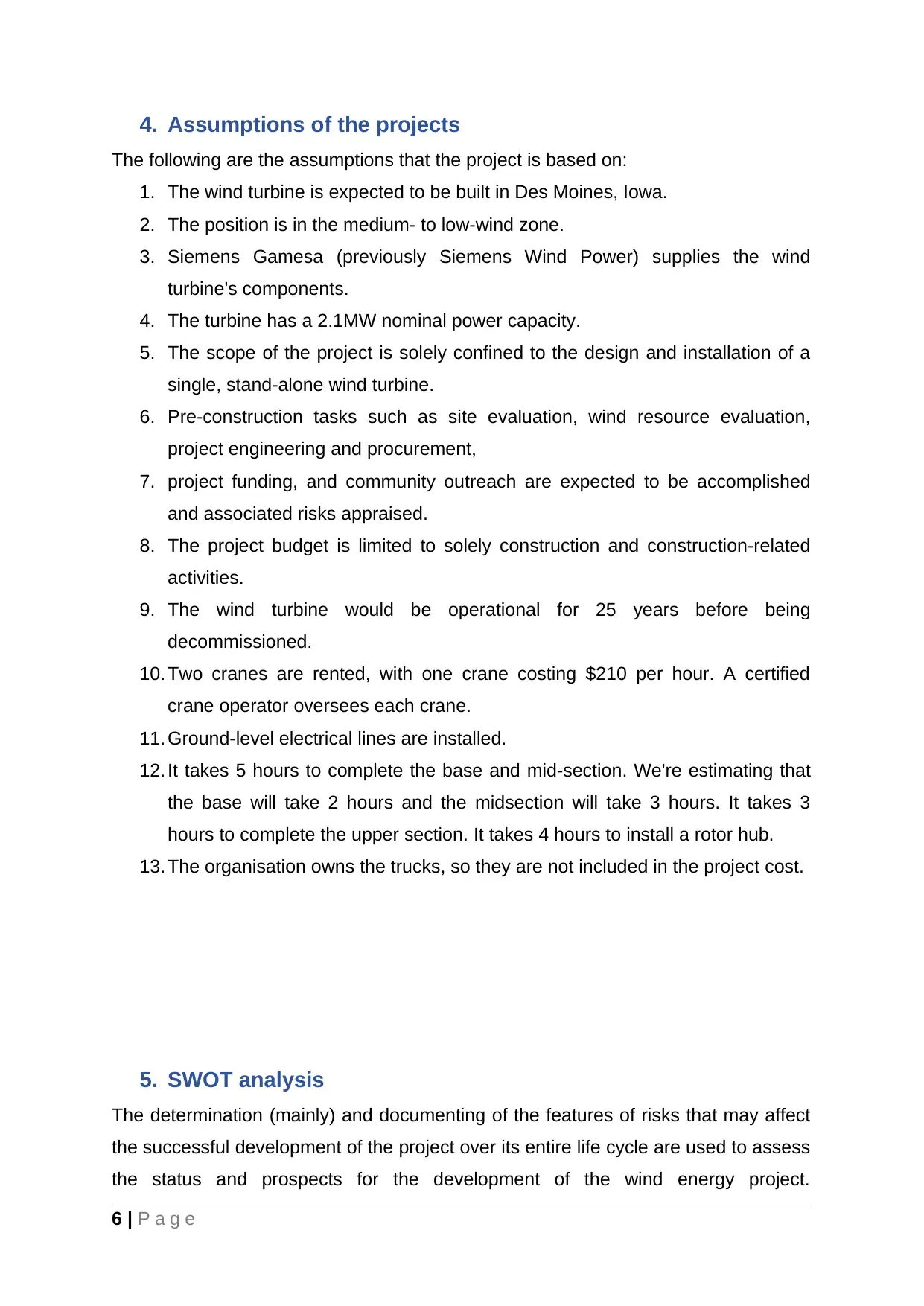
4. Assumptions of the projects
The following are the assumptions that the project is based on:
1. The wind turbine is expected to be built in Des Moines, Iowa.
2. The position is in the medium- to low-wind zone.
3. Siemens Gamesa (previously Siemens Wind Power) supplies the wind
turbine's components.
4. The turbine has a 2.1MW nominal power capacity.
5. The scope of the project is solely confined to the design and installation of a
single, stand-alone wind turbine.
6. Pre-construction tasks such as site evaluation, wind resource evaluation,
project engineering and procurement,
7. project funding, and community outreach are expected to be accomplished
and associated risks appraised.
8. The project budget is limited to solely construction and construction-related
activities.
9. The wind turbine would be operational for 25 years before being
decommissioned.
10. Two cranes are rented, with one crane costing $210 per hour. A certified
crane operator oversees each crane.
11. Ground-level electrical lines are installed.
12. It takes 5 hours to complete the base and mid-section. We're estimating that
the base will take 2 hours and the midsection will take 3 hours. It takes 3
hours to complete the upper section. It takes 4 hours to install a rotor hub.
13. The organisation owns the trucks, so they are not included in the project cost.
5. SWOT analysis
The determination (mainly) and documenting of the features of risks that may affect
the successful development of the project over its entire life cycle are used to assess
the status and prospects for the development of the wind energy project.
6 | P a g e
The following are the assumptions that the project is based on:
1. The wind turbine is expected to be built in Des Moines, Iowa.
2. The position is in the medium- to low-wind zone.
3. Siemens Gamesa (previously Siemens Wind Power) supplies the wind
turbine's components.
4. The turbine has a 2.1MW nominal power capacity.
5. The scope of the project is solely confined to the design and installation of a
single, stand-alone wind turbine.
6. Pre-construction tasks such as site evaluation, wind resource evaluation,
project engineering and procurement,
7. project funding, and community outreach are expected to be accomplished
and associated risks appraised.
8. The project budget is limited to solely construction and construction-related
activities.
9. The wind turbine would be operational for 25 years before being
decommissioned.
10. Two cranes are rented, with one crane costing $210 per hour. A certified
crane operator oversees each crane.
11. Ground-level electrical lines are installed.
12. It takes 5 hours to complete the base and mid-section. We're estimating that
the base will take 2 hours and the midsection will take 3 hours. It takes 3
hours to complete the upper section. It takes 4 hours to install a rotor hub.
13. The organisation owns the trucks, so they are not included in the project cost.
5. SWOT analysis
The determination (mainly) and documenting of the features of risks that may affect
the successful development of the project over its entire life cycle are used to assess
the status and prospects for the development of the wind energy project.
6 | P a g e
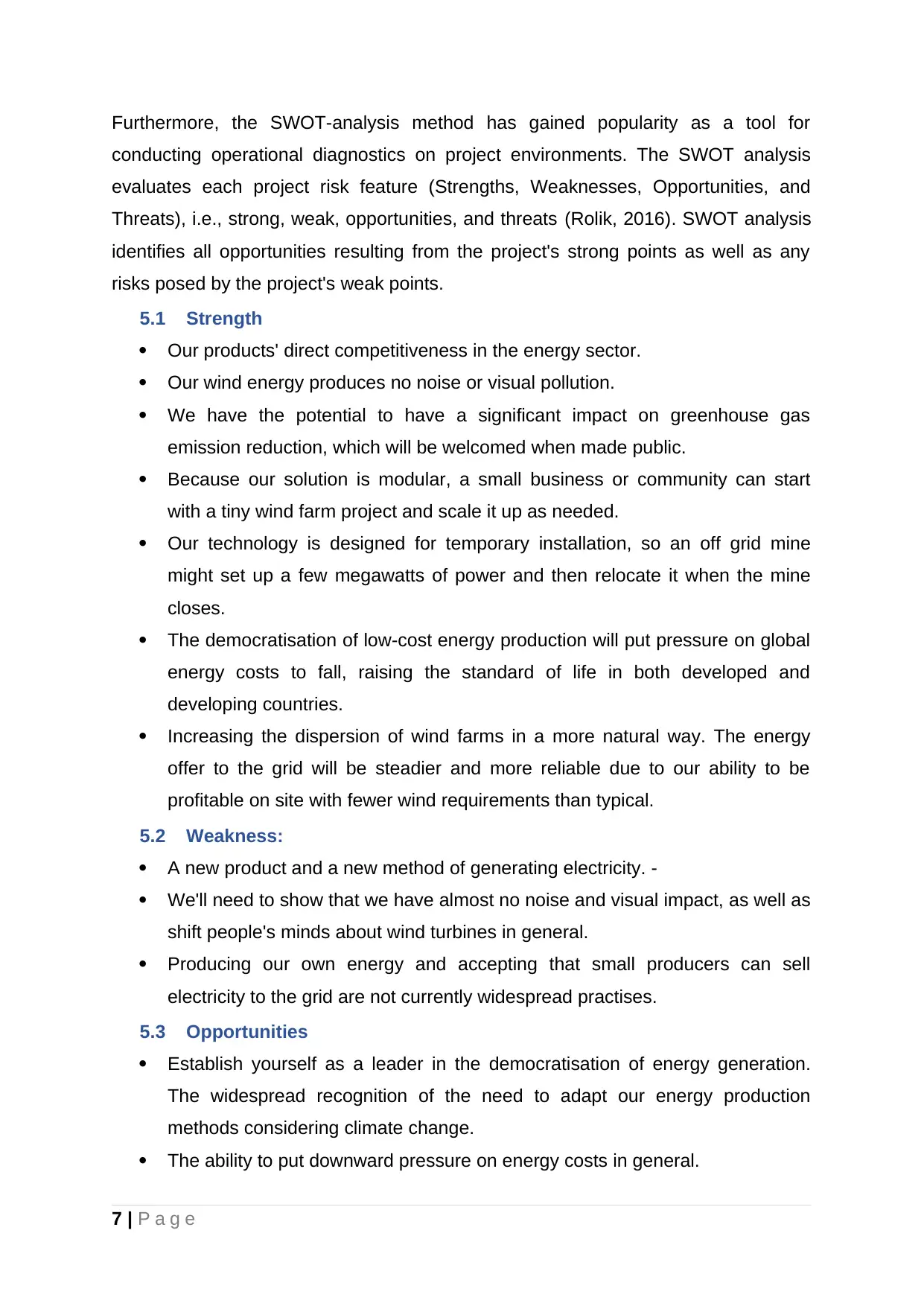
Furthermore, the SWOT-analysis method has gained popularity as a tool for
conducting operational diagnostics on project environments. The SWOT analysis
evaluates each project risk feature (Strengths, Weaknesses, Opportunities, and
Threats), i.e., strong, weak, opportunities, and threats (Rolik, 2016). SWOT analysis
identifies all opportunities resulting from the project's strong points as well as any
risks posed by the project's weak points.
5.1 Strength
Our products' direct competitiveness in the energy sector.
Our wind energy produces no noise or visual pollution.
We have the potential to have a significant impact on greenhouse gas
emission reduction, which will be welcomed when made public.
Because our solution is modular, a small business or community can start
with a tiny wind farm project and scale it up as needed.
Our technology is designed for temporary installation, so an off grid mine
might set up a few megawatts of power and then relocate it when the mine
closes.
The democratisation of low-cost energy production will put pressure on global
energy costs to fall, raising the standard of life in both developed and
developing countries.
Increasing the dispersion of wind farms in a more natural way. The energy
offer to the grid will be steadier and more reliable due to our ability to be
profitable on site with fewer wind requirements than typical.
5.2 Weakness:
A new product and a new method of generating electricity. -
We'll need to show that we have almost no noise and visual impact, as well as
shift people's minds about wind turbines in general.
Producing our own energy and accepting that small producers can sell
electricity to the grid are not currently widespread practises.
5.3 Opportunities
Establish yourself as a leader in the democratisation of energy generation.
The widespread recognition of the need to adapt our energy production
methods considering climate change.
The ability to put downward pressure on energy costs in general.
7 | P a g e
conducting operational diagnostics on project environments. The SWOT analysis
evaluates each project risk feature (Strengths, Weaknesses, Opportunities, and
Threats), i.e., strong, weak, opportunities, and threats (Rolik, 2016). SWOT analysis
identifies all opportunities resulting from the project's strong points as well as any
risks posed by the project's weak points.
5.1 Strength
Our products' direct competitiveness in the energy sector.
Our wind energy produces no noise or visual pollution.
We have the potential to have a significant impact on greenhouse gas
emission reduction, which will be welcomed when made public.
Because our solution is modular, a small business or community can start
with a tiny wind farm project and scale it up as needed.
Our technology is designed for temporary installation, so an off grid mine
might set up a few megawatts of power and then relocate it when the mine
closes.
The democratisation of low-cost energy production will put pressure on global
energy costs to fall, raising the standard of life in both developed and
developing countries.
Increasing the dispersion of wind farms in a more natural way. The energy
offer to the grid will be steadier and more reliable due to our ability to be
profitable on site with fewer wind requirements than typical.
5.2 Weakness:
A new product and a new method of generating electricity. -
We'll need to show that we have almost no noise and visual impact, as well as
shift people's minds about wind turbines in general.
Producing our own energy and accepting that small producers can sell
electricity to the grid are not currently widespread practises.
5.3 Opportunities
Establish yourself as a leader in the democratisation of energy generation.
The widespread recognition of the need to adapt our energy production
methods considering climate change.
The ability to put downward pressure on energy costs in general.
7 | P a g e
Paraphrase This Document
Need a fresh take? Get an instant paraphrase of this document with our AI Paraphraser
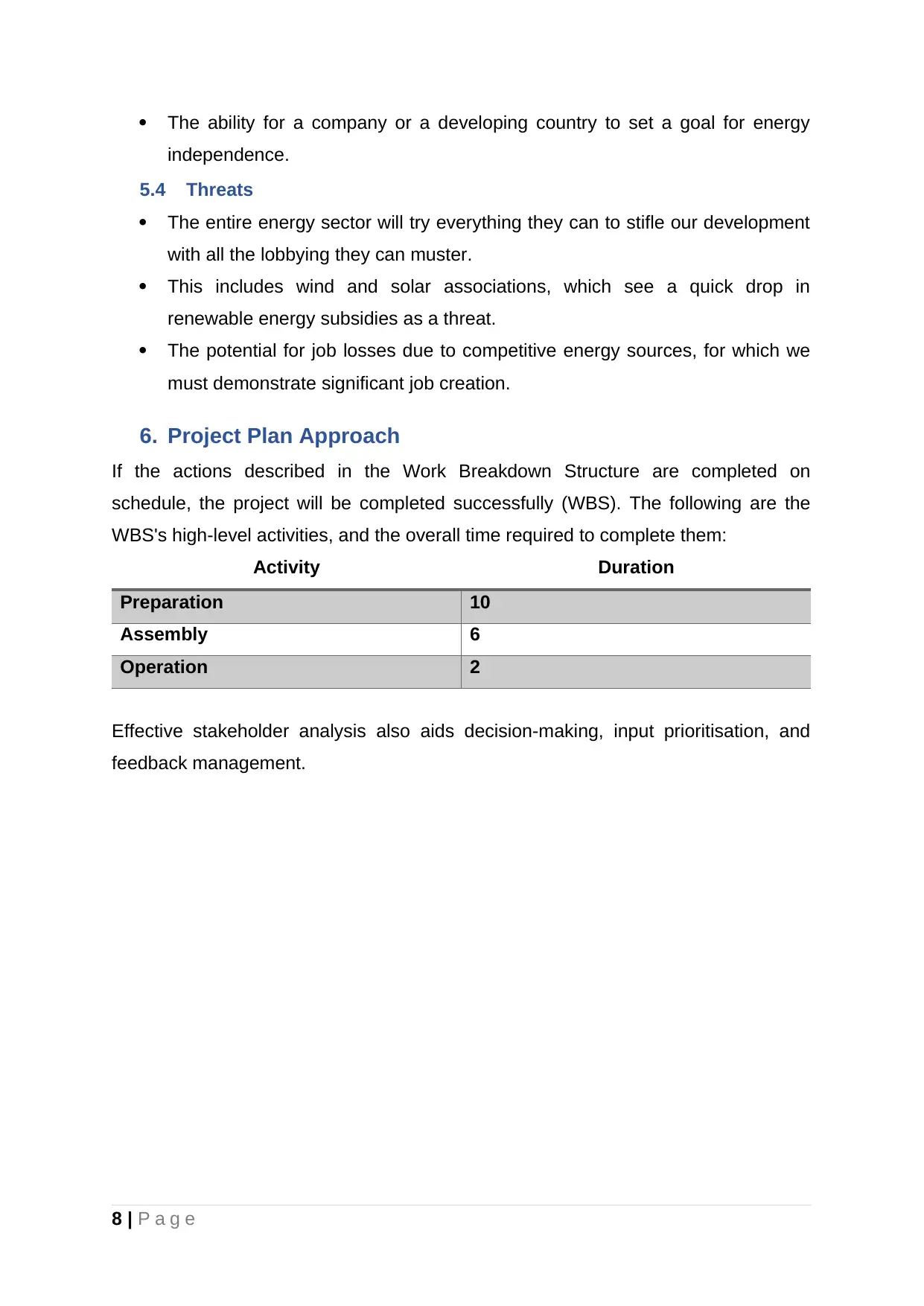
The ability for a company or a developing country to set a goal for energy
independence.
5.4 Threats
The entire energy sector will try everything they can to stifle our development
with all the lobbying they can muster.
This includes wind and solar associations, which see a quick drop in
renewable energy subsidies as a threat.
The potential for job losses due to competitive energy sources, for which we
must demonstrate significant job creation.
6. Project Plan Approach
If the actions described in the Work Breakdown Structure are completed on
schedule, the project will be completed successfully (WBS). The following are the
WBS's high-level activities, and the overall time required to complete them:
Activity Duration
Preparation 10
Assembly 6
Operation 2
Effective stakeholder analysis also aids decision-making, input prioritisation, and
feedback management.
8 | P a g e
independence.
5.4 Threats
The entire energy sector will try everything they can to stifle our development
with all the lobbying they can muster.
This includes wind and solar associations, which see a quick drop in
renewable energy subsidies as a threat.
The potential for job losses due to competitive energy sources, for which we
must demonstrate significant job creation.
6. Project Plan Approach
If the actions described in the Work Breakdown Structure are completed on
schedule, the project will be completed successfully (WBS). The following are the
WBS's high-level activities, and the overall time required to complete them:
Activity Duration
Preparation 10
Assembly 6
Operation 2
Effective stakeholder analysis also aids decision-making, input prioritisation, and
feedback management.
8 | P a g e
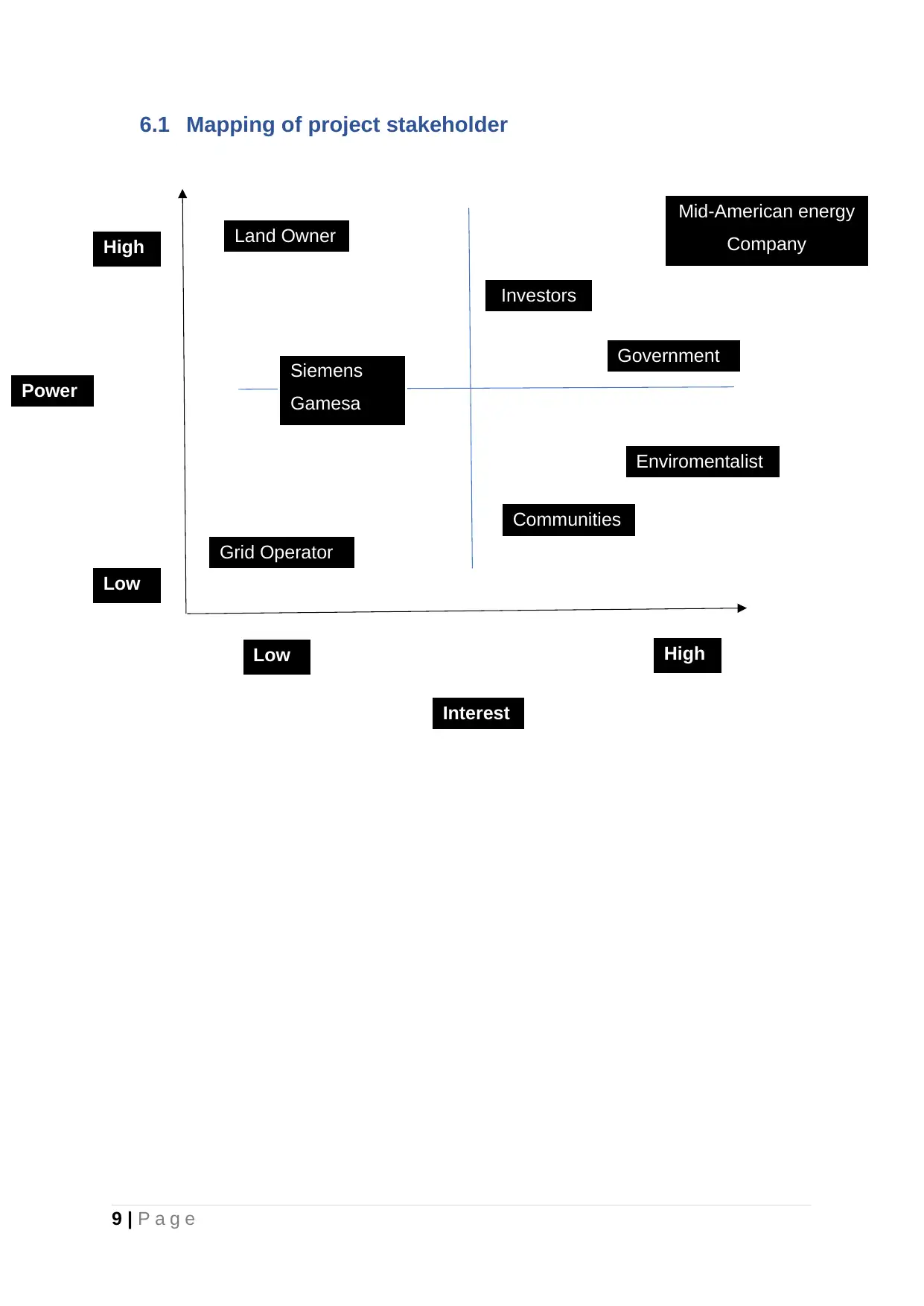
6.1 Mapping of project stakeholder
9 | P a g e
Land Owner
Enviromentalist
Grid Operator
Siemens
Gamesa
Government
Investors
Mid-American energy
Company
Power
HighLow
High
Low
Communities
Interest
9 | P a g e
Land Owner
Enviromentalist
Grid Operator
Siemens
Gamesa
Government
Investors
Mid-American energy
Company
Power
HighLow
High
Low
Communities
Interest
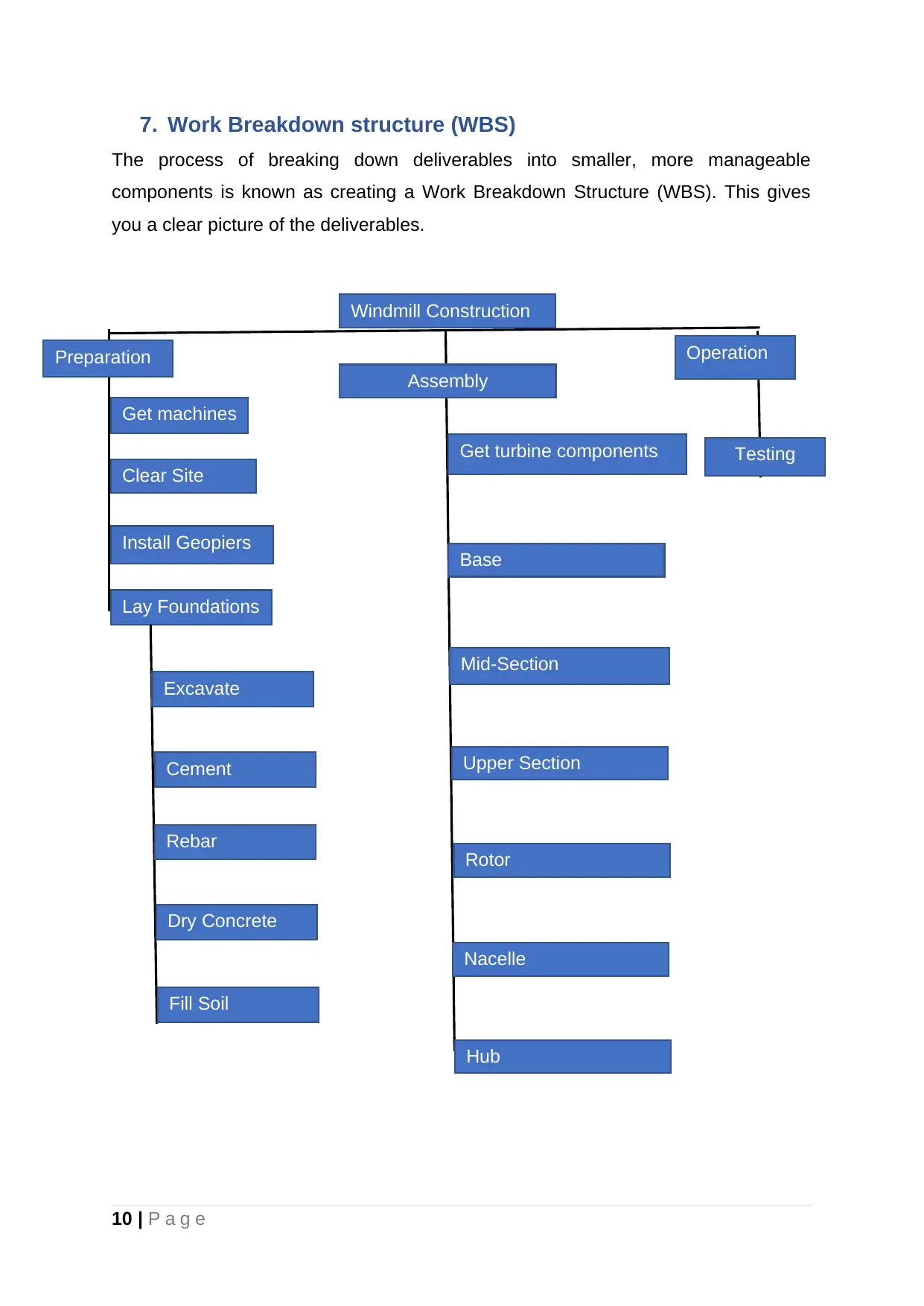
7. Work Breakdown structure (WBS)
The process of breaking down deliverables into smaller, more manageable
components is known as creating a Work Breakdown Structure (WBS). This gives
you a clear picture of the deliverables.
10 | P a g e
Windmill Construction
Assembly
Base
Mid-Section
Upper Section
Rotor
Nacelle
Hub
Clear Site
Get machines
Preparation
Install Geopiers
Lay Foundations
Excavate
Cement
Rebar
Dry Concrete
Fill Soil
Get turbine components Testing
Operation
The process of breaking down deliverables into smaller, more manageable
components is known as creating a Work Breakdown Structure (WBS). This gives
you a clear picture of the deliverables.
10 | P a g e
Windmill Construction
Assembly
Base
Mid-Section
Upper Section
Rotor
Nacelle
Hub
Clear Site
Get machines
Preparation
Install Geopiers
Lay Foundations
Excavate
Cement
Rebar
Dry Concrete
Fill Soil
Get turbine components Testing
Operation
Secure Best Marks with AI Grader
Need help grading? Try our AI Grader for instant feedback on your assignments.
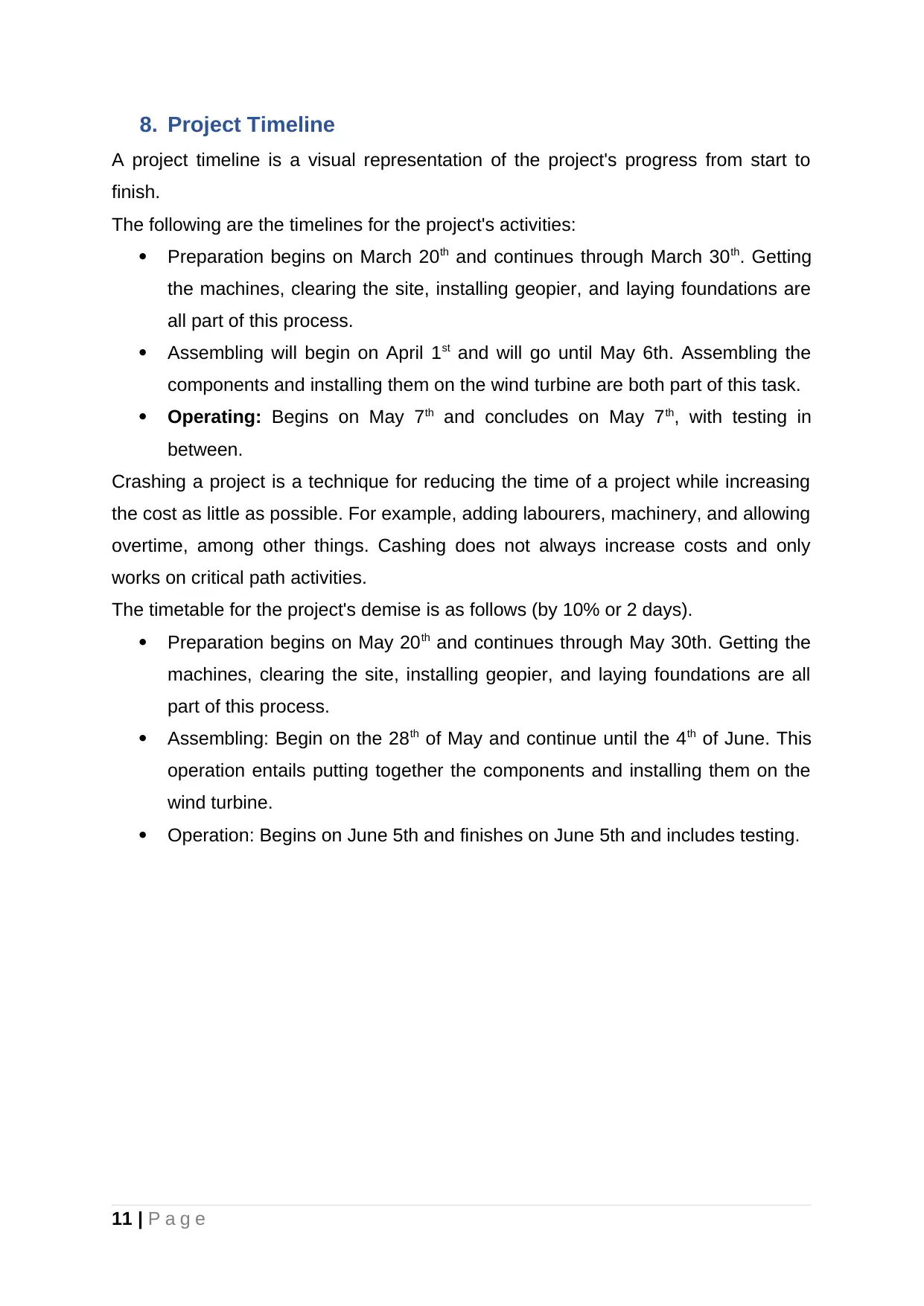
8. Project Timeline
A project timeline is a visual representation of the project's progress from start to
finish.
The following are the timelines for the project's activities:
Preparation begins on March 20th and continues through March 30th. Getting
the machines, clearing the site, installing geopier, and laying foundations are
all part of this process.
Assembling will begin on April 1st and will go until May 6th. Assembling the
components and installing them on the wind turbine are both part of this task.
Operating: Begins on May 7th and concludes on May 7th, with testing in
between.
Crashing a project is a technique for reducing the time of a project while increasing
the cost as little as possible. For example, adding labourers, machinery, and allowing
overtime, among other things. Cashing does not always increase costs and only
works on critical path activities.
The timetable for the project's demise is as follows (by 10% or 2 days).
Preparation begins on May 20th and continues through May 30th. Getting the
machines, clearing the site, installing geopier, and laying foundations are all
part of this process.
Assembling: Begin on the 28th of May and continue until the 4th of June. This
operation entails putting together the components and installing them on the
wind turbine.
Operation: Begins on June 5th and finishes on June 5th and includes testing.
11 | P a g e
A project timeline is a visual representation of the project's progress from start to
finish.
The following are the timelines for the project's activities:
Preparation begins on March 20th and continues through March 30th. Getting
the machines, clearing the site, installing geopier, and laying foundations are
all part of this process.
Assembling will begin on April 1st and will go until May 6th. Assembling the
components and installing them on the wind turbine are both part of this task.
Operating: Begins on May 7th and concludes on May 7th, with testing in
between.
Crashing a project is a technique for reducing the time of a project while increasing
the cost as little as possible. For example, adding labourers, machinery, and allowing
overtime, among other things. Cashing does not always increase costs and only
works on critical path activities.
The timetable for the project's demise is as follows (by 10% or 2 days).
Preparation begins on May 20th and continues through May 30th. Getting the
machines, clearing the site, installing geopier, and laying foundations are all
part of this process.
Assembling: Begin on the 28th of May and continue until the 4th of June. This
operation entails putting together the components and installing them on the
wind turbine.
Operation: Begins on June 5th and finishes on June 5th and includes testing.
11 | P a g e
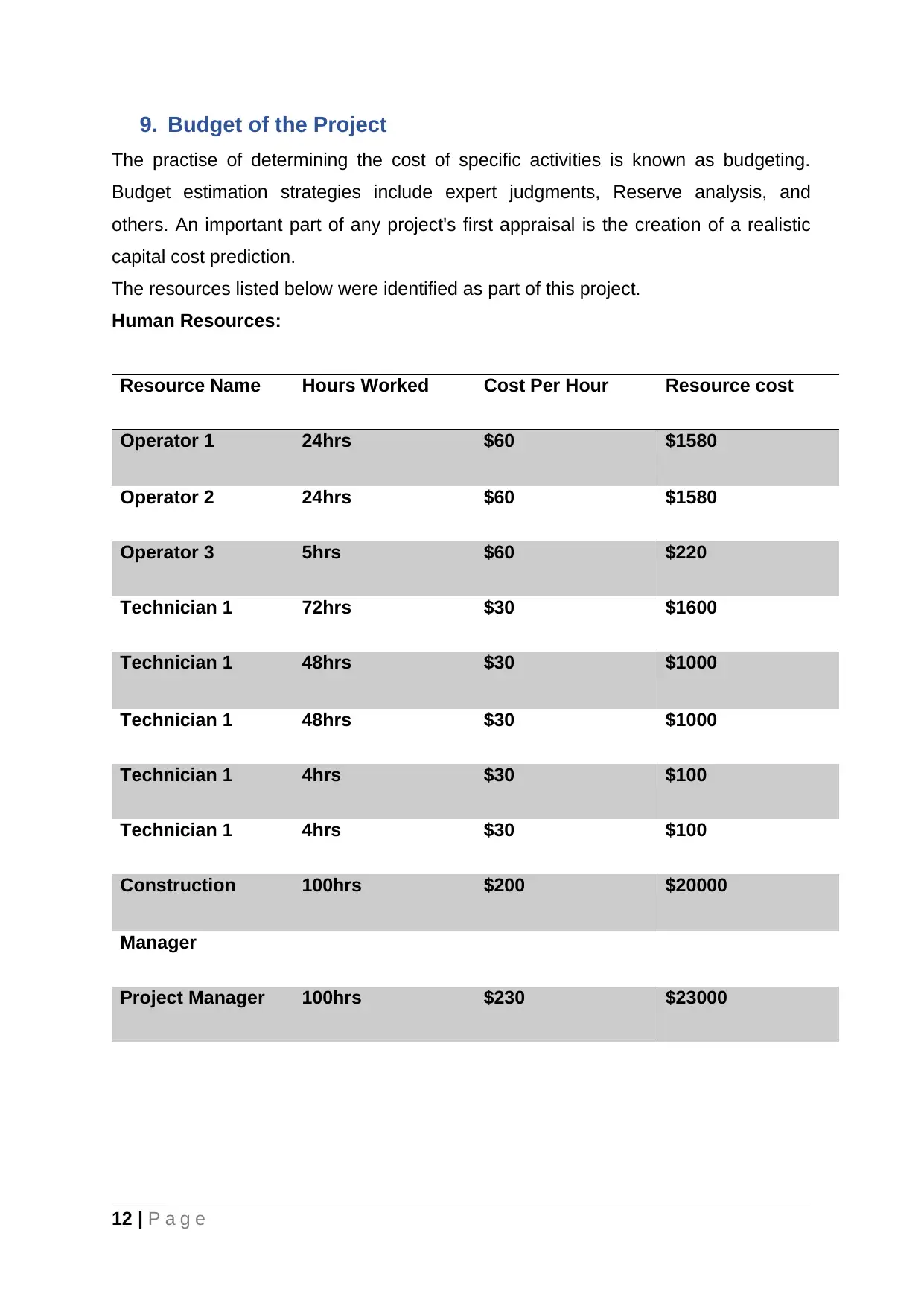
9. Budget of the Project
The practise of determining the cost of specific activities is known as budgeting.
Budget estimation strategies include expert judgments, Reserve analysis, and
others. An important part of any project's first appraisal is the creation of a realistic
capital cost prediction.
The resources listed below were identified as part of this project.
Human Resources:
Resource Name Hours Worked Cost Per Hour Resource cost
Operator 1 24hrs $60 $1580
Operator 2 24hrs $60 $1580
Operator 3 5hrs $60 $220
Technician 1 72hrs $30 $1600
Technician 1 48hrs $30 $1000
Technician 1 48hrs $30 $1000
Technician 1 4hrs $30 $100
Technician 1 4hrs $30 $100
Construction 100hrs $200 $20000
Manager
Project Manager 100hrs $230 $23000
12 | P a g e
The practise of determining the cost of specific activities is known as budgeting.
Budget estimation strategies include expert judgments, Reserve analysis, and
others. An important part of any project's first appraisal is the creation of a realistic
capital cost prediction.
The resources listed below were identified as part of this project.
Human Resources:
Resource Name Hours Worked Cost Per Hour Resource cost
Operator 1 24hrs $60 $1580
Operator 2 24hrs $60 $1580
Operator 3 5hrs $60 $220
Technician 1 72hrs $30 $1600
Technician 1 48hrs $30 $1000
Technician 1 48hrs $30 $1000
Technician 1 4hrs $30 $100
Technician 1 4hrs $30 $100
Construction 100hrs $200 $20000
Manager
Project Manager 100hrs $230 $23000
12 | P a g e
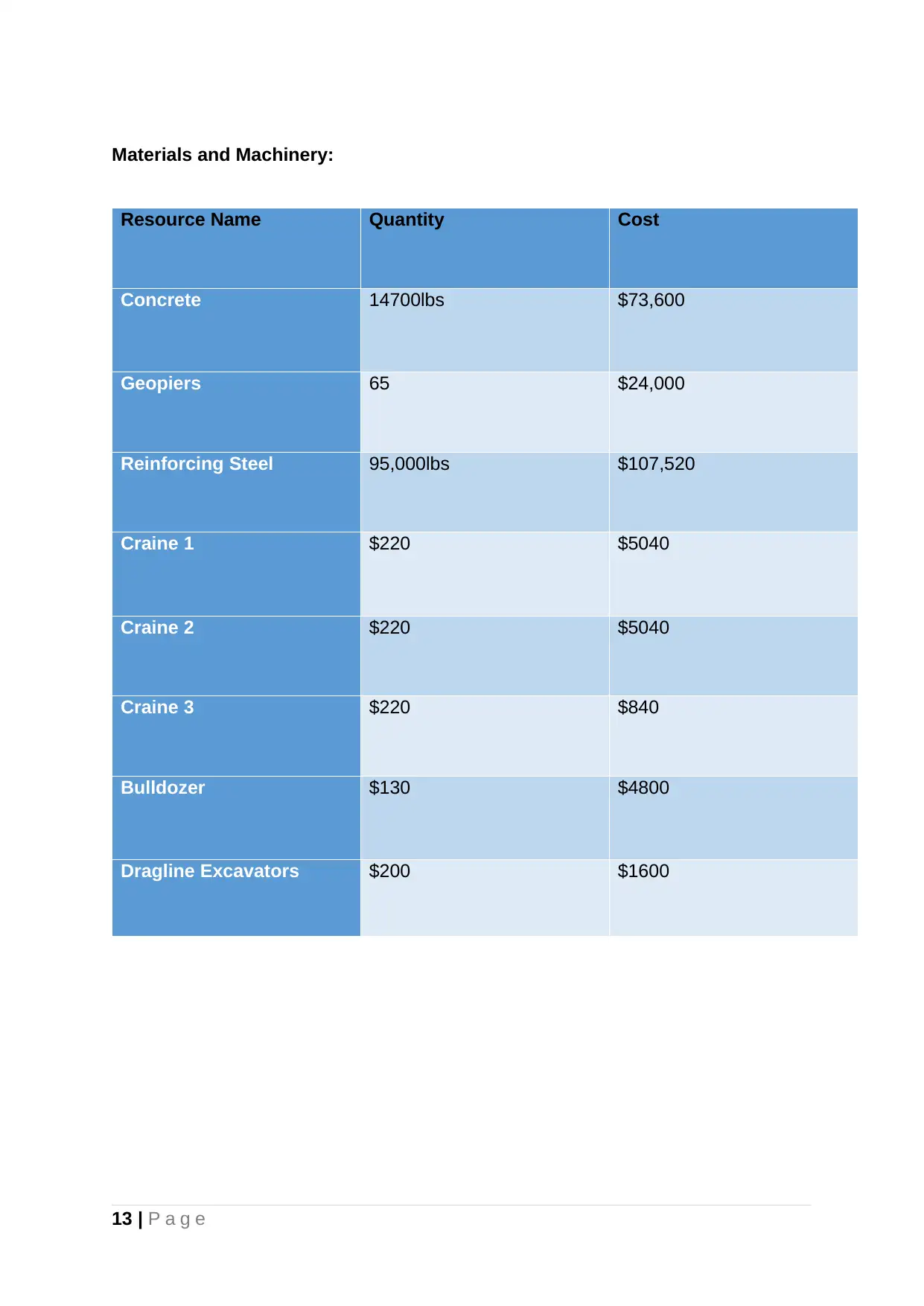
Materials and Machinery:
Resource Name Quantity Cost
Concrete 14700lbs $73,600
Geopiers 65 $24,000
Reinforcing Steel 95,000lbs $107,520
Craine 1 $220 $5040
Craine 2 $220 $5040
Craine 3 $220 $840
Bulldozer $130 $4800
Dragline Excavators $200 $1600
13 | P a g e
Resource Name Quantity Cost
Concrete 14700lbs $73,600
Geopiers 65 $24,000
Reinforcing Steel 95,000lbs $107,520
Craine 1 $220 $5040
Craine 2 $220 $5040
Craine 3 $220 $840
Bulldozer $130 $4800
Dragline Excavators $200 $1600
13 | P a g e
Paraphrase This Document
Need a fresh take? Get an instant paraphrase of this document with our AI Paraphraser
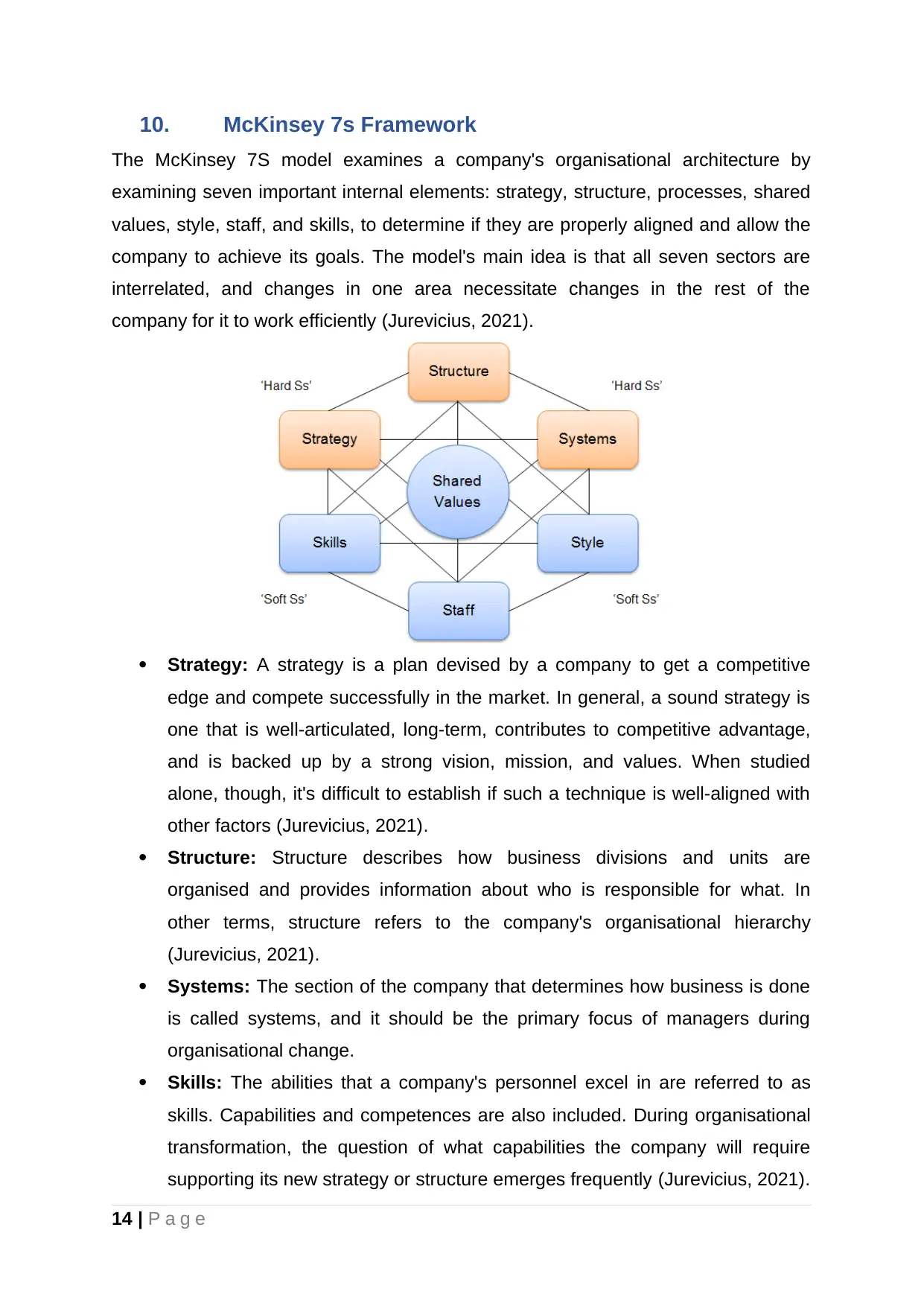
10. McKinsey 7s Framework
The McKinsey 7S model examines a company's organisational architecture by
examining seven important internal elements: strategy, structure, processes, shared
values, style, staff, and skills, to determine if they are properly aligned and allow the
company to achieve its goals. The model's main idea is that all seven sectors are
interrelated, and changes in one area necessitate changes in the rest of the
company for it to work efficiently (Jurevicius, 2021).
Strategy: A strategy is a plan devised by a company to get a competitive
edge and compete successfully in the market. In general, a sound strategy is
one that is well-articulated, long-term, contributes to competitive advantage,
and is backed up by a strong vision, mission, and values. When studied
alone, though, it's difficult to establish if such a technique is well-aligned with
other factors (Jurevicius, 2021).
Structure: Structure describes how business divisions and units are
organised and provides information about who is responsible for what. In
other terms, structure refers to the company's organisational hierarchy
(Jurevicius, 2021).
Systems: The section of the company that determines how business is done
is called systems, and it should be the primary focus of managers during
organisational change.
Skills: The abilities that a company's personnel excel in are referred to as
skills. Capabilities and competences are also included. During organisational
transformation, the question of what capabilities the company will require
supporting its new strategy or structure emerges frequently (Jurevicius, 2021).
14 | P a g e
The McKinsey 7S model examines a company's organisational architecture by
examining seven important internal elements: strategy, structure, processes, shared
values, style, staff, and skills, to determine if they are properly aligned and allow the
company to achieve its goals. The model's main idea is that all seven sectors are
interrelated, and changes in one area necessitate changes in the rest of the
company for it to work efficiently (Jurevicius, 2021).
Strategy: A strategy is a plan devised by a company to get a competitive
edge and compete successfully in the market. In general, a sound strategy is
one that is well-articulated, long-term, contributes to competitive advantage,
and is backed up by a strong vision, mission, and values. When studied
alone, though, it's difficult to establish if such a technique is well-aligned with
other factors (Jurevicius, 2021).
Structure: Structure describes how business divisions and units are
organised and provides information about who is responsible for what. In
other terms, structure refers to the company's organisational hierarchy
(Jurevicius, 2021).
Systems: The section of the company that determines how business is done
is called systems, and it should be the primary focus of managers during
organisational change.
Skills: The abilities that a company's personnel excel in are referred to as
skills. Capabilities and competences are also included. During organisational
transformation, the question of what capabilities the company will require
supporting its new strategy or structure emerges frequently (Jurevicius, 2021).
14 | P a g e
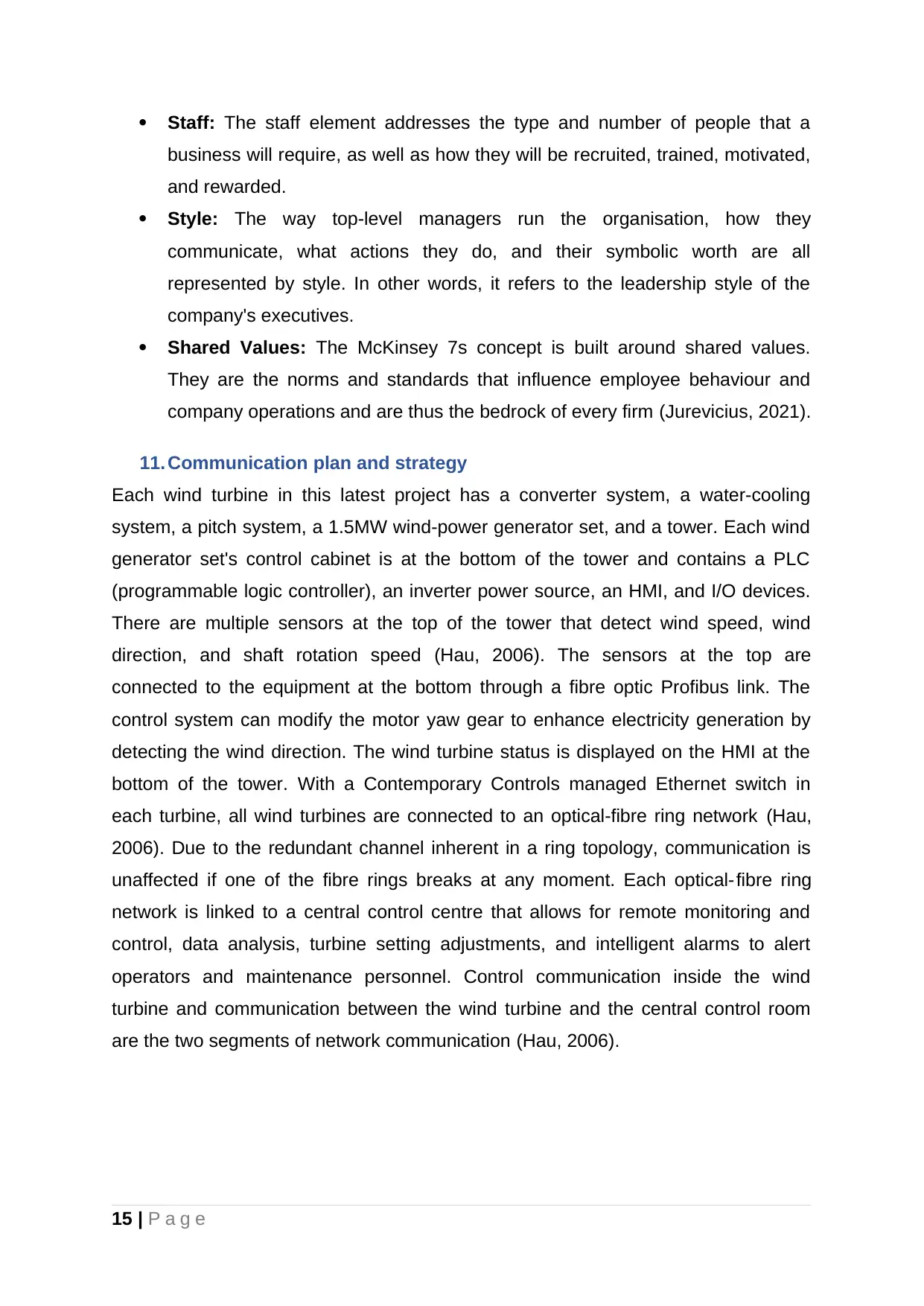
Staff: The staff element addresses the type and number of people that a
business will require, as well as how they will be recruited, trained, motivated,
and rewarded.
Style: The way top-level managers run the organisation, how they
communicate, what actions they do, and their symbolic worth are all
represented by style. In other words, it refers to the leadership style of the
company's executives.
Shared Values: The McKinsey 7s concept is built around shared values.
They are the norms and standards that influence employee behaviour and
company operations and are thus the bedrock of every firm (Jurevicius, 2021).
11. Communication plan and strategy
Each wind turbine in this latest project has a converter system, a water-cooling
system, a pitch system, a 1.5MW wind-power generator set, and a tower. Each wind
generator set's control cabinet is at the bottom of the tower and contains a PLC
(programmable logic controller), an inverter power source, an HMI, and I/O devices.
There are multiple sensors at the top of the tower that detect wind speed, wind
direction, and shaft rotation speed (Hau, 2006). The sensors at the top are
connected to the equipment at the bottom through a fibre optic Profibus link. The
control system can modify the motor yaw gear to enhance electricity generation by
detecting the wind direction. The wind turbine status is displayed on the HMI at the
bottom of the tower. With a Contemporary Controls managed Ethernet switch in
each turbine, all wind turbines are connected to an optical-fibre ring network (Hau,
2006). Due to the redundant channel inherent in a ring topology, communication is
unaffected if one of the fibre rings breaks at any moment. Each optical-fibre ring
network is linked to a central control centre that allows for remote monitoring and
control, data analysis, turbine setting adjustments, and intelligent alarms to alert
operators and maintenance personnel. Control communication inside the wind
turbine and communication between the wind turbine and the central control room
are the two segments of network communication (Hau, 2006).
15 | P a g e
business will require, as well as how they will be recruited, trained, motivated,
and rewarded.
Style: The way top-level managers run the organisation, how they
communicate, what actions they do, and their symbolic worth are all
represented by style. In other words, it refers to the leadership style of the
company's executives.
Shared Values: The McKinsey 7s concept is built around shared values.
They are the norms and standards that influence employee behaviour and
company operations and are thus the bedrock of every firm (Jurevicius, 2021).
11. Communication plan and strategy
Each wind turbine in this latest project has a converter system, a water-cooling
system, a pitch system, a 1.5MW wind-power generator set, and a tower. Each wind
generator set's control cabinet is at the bottom of the tower and contains a PLC
(programmable logic controller), an inverter power source, an HMI, and I/O devices.
There are multiple sensors at the top of the tower that detect wind speed, wind
direction, and shaft rotation speed (Hau, 2006). The sensors at the top are
connected to the equipment at the bottom through a fibre optic Profibus link. The
control system can modify the motor yaw gear to enhance electricity generation by
detecting the wind direction. The wind turbine status is displayed on the HMI at the
bottom of the tower. With a Contemporary Controls managed Ethernet switch in
each turbine, all wind turbines are connected to an optical-fibre ring network (Hau,
2006). Due to the redundant channel inherent in a ring topology, communication is
unaffected if one of the fibre rings breaks at any moment. Each optical-fibre ring
network is linked to a central control centre that allows for remote monitoring and
control, data analysis, turbine setting adjustments, and intelligent alarms to alert
operators and maintenance personnel. Control communication inside the wind
turbine and communication between the wind turbine and the central control room
are the two segments of network communication (Hau, 2006).
15 | P a g e
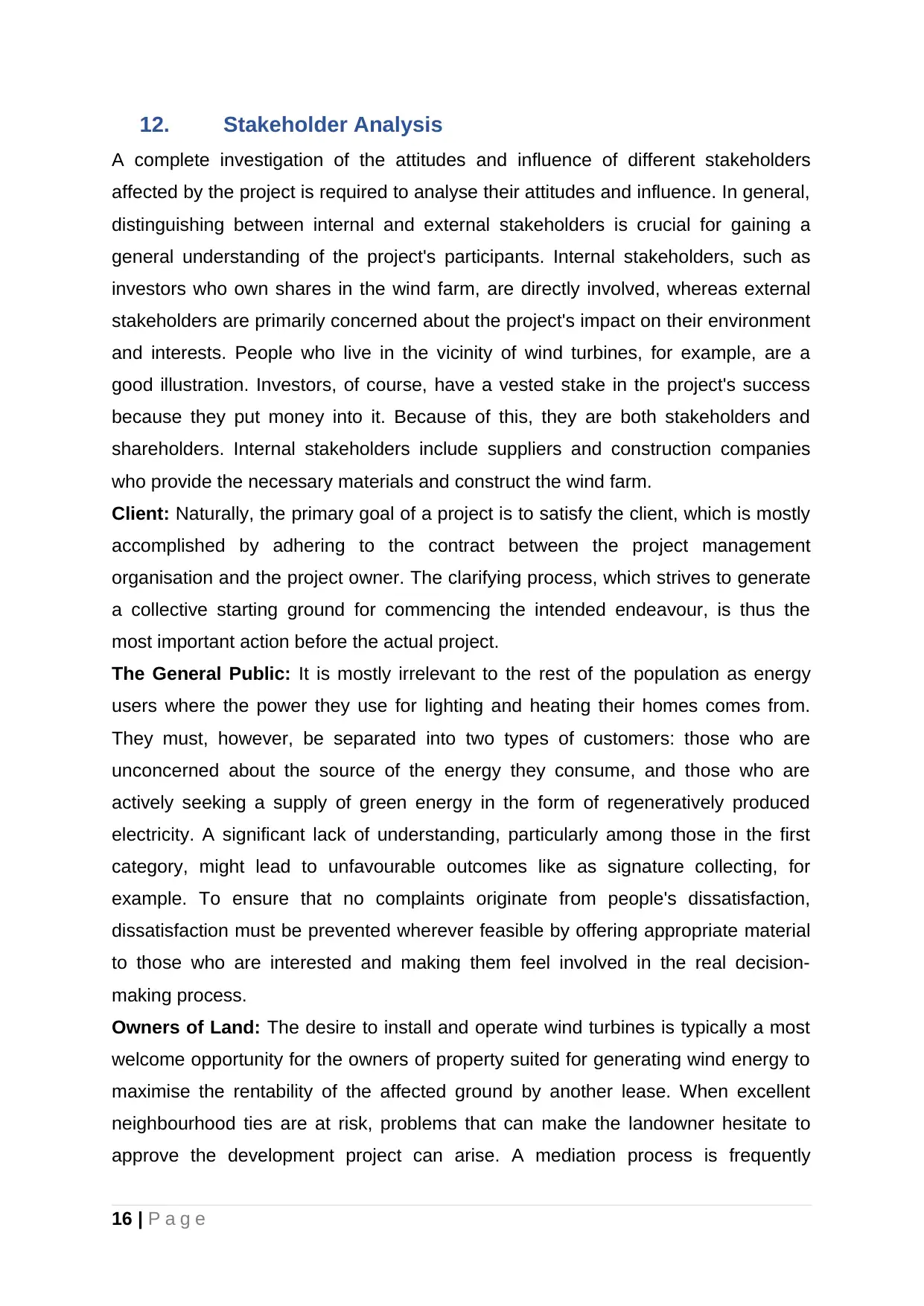
12. Stakeholder Analysis
A complete investigation of the attitudes and influence of different stakeholders
affected by the project is required to analyse their attitudes and influence. In general,
distinguishing between internal and external stakeholders is crucial for gaining a
general understanding of the project's participants. Internal stakeholders, such as
investors who own shares in the wind farm, are directly involved, whereas external
stakeholders are primarily concerned about the project's impact on their environment
and interests. People who live in the vicinity of wind turbines, for example, are a
good illustration. Investors, of course, have a vested stake in the project's success
because they put money into it. Because of this, they are both stakeholders and
shareholders. Internal stakeholders include suppliers and construction companies
who provide the necessary materials and construct the wind farm.
Client: Naturally, the primary goal of a project is to satisfy the client, which is mostly
accomplished by adhering to the contract between the project management
organisation and the project owner. The clarifying process, which strives to generate
a collective starting ground for commencing the intended endeavour, is thus the
most important action before the actual project.
The General Public: It is mostly irrelevant to the rest of the population as energy
users where the power they use for lighting and heating their homes comes from.
They must, however, be separated into two types of customers: those who are
unconcerned about the source of the energy they consume, and those who are
actively seeking a supply of green energy in the form of regeneratively produced
electricity. A significant lack of understanding, particularly among those in the first
category, might lead to unfavourable outcomes like as signature collecting, for
example. To ensure that no complaints originate from people's dissatisfaction,
dissatisfaction must be prevented wherever feasible by offering appropriate material
to those who are interested and making them feel involved in the real decision-
making process.
Owners of Land: The desire to install and operate wind turbines is typically a most
welcome opportunity for the owners of property suited for generating wind energy to
maximise the rentability of the affected ground by another lease. When excellent
neighbourhood ties are at risk, problems that can make the landowner hesitate to
approve the development project can arise. A mediation process is frequently
16 | P a g e
A complete investigation of the attitudes and influence of different stakeholders
affected by the project is required to analyse their attitudes and influence. In general,
distinguishing between internal and external stakeholders is crucial for gaining a
general understanding of the project's participants. Internal stakeholders, such as
investors who own shares in the wind farm, are directly involved, whereas external
stakeholders are primarily concerned about the project's impact on their environment
and interests. People who live in the vicinity of wind turbines, for example, are a
good illustration. Investors, of course, have a vested stake in the project's success
because they put money into it. Because of this, they are both stakeholders and
shareholders. Internal stakeholders include suppliers and construction companies
who provide the necessary materials and construct the wind farm.
Client: Naturally, the primary goal of a project is to satisfy the client, which is mostly
accomplished by adhering to the contract between the project management
organisation and the project owner. The clarifying process, which strives to generate
a collective starting ground for commencing the intended endeavour, is thus the
most important action before the actual project.
The General Public: It is mostly irrelevant to the rest of the population as energy
users where the power they use for lighting and heating their homes comes from.
They must, however, be separated into two types of customers: those who are
unconcerned about the source of the energy they consume, and those who are
actively seeking a supply of green energy in the form of regeneratively produced
electricity. A significant lack of understanding, particularly among those in the first
category, might lead to unfavourable outcomes like as signature collecting, for
example. To ensure that no complaints originate from people's dissatisfaction,
dissatisfaction must be prevented wherever feasible by offering appropriate material
to those who are interested and making them feel involved in the real decision-
making process.
Owners of Land: The desire to install and operate wind turbines is typically a most
welcome opportunity for the owners of property suited for generating wind energy to
maximise the rentability of the affected ground by another lease. When excellent
neighbourhood ties are at risk, problems that can make the landowner hesitate to
approve the development project can arise. A mediation process is frequently
16 | P a g e
Secure Best Marks with AI Grader
Need help grading? Try our AI Grader for instant feedback on your assignments.
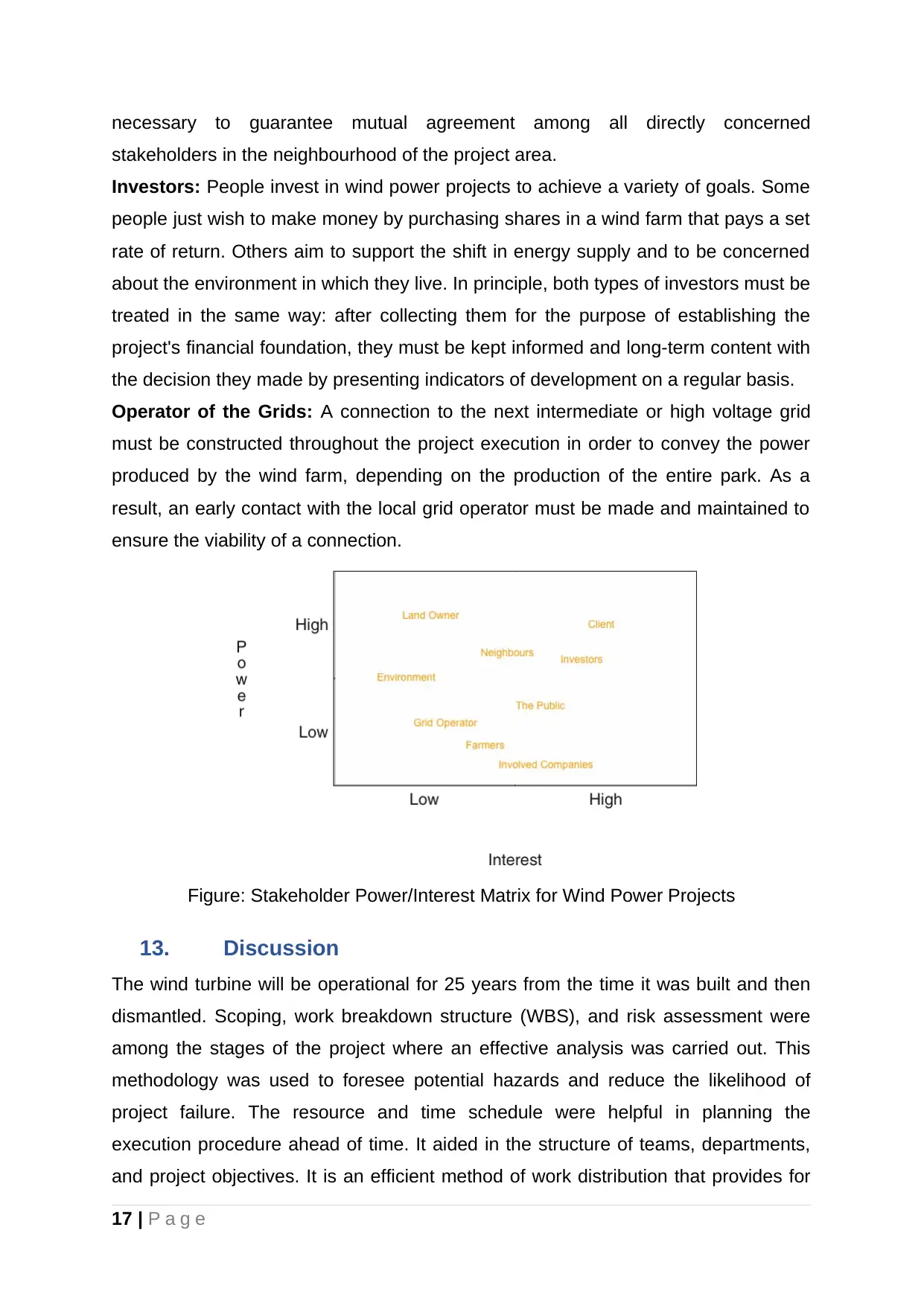
necessary to guarantee mutual agreement among all directly concerned
stakeholders in the neighbourhood of the project area.
Investors: People invest in wind power projects to achieve a variety of goals. Some
people just wish to make money by purchasing shares in a wind farm that pays a set
rate of return. Others aim to support the shift in energy supply and to be concerned
about the environment in which they live. In principle, both types of investors must be
treated in the same way: after collecting them for the purpose of establishing the
project's financial foundation, they must be kept informed and long-term content with
the decision they made by presenting indicators of development on a regular basis.
Operator of the Grids: A connection to the next intermediate or high voltage grid
must be constructed throughout the project execution in order to convey the power
produced by the wind farm, depending on the production of the entire park. As a
result, an early contact with the local grid operator must be made and maintained to
ensure the viability of a connection.
Figure: Stakeholder Power/Interest Matrix for Wind Power Projects
13. Discussion
The wind turbine will be operational for 25 years from the time it was built and then
dismantled. Scoping, work breakdown structure (WBS), and risk assessment were
among the stages of the project where an effective analysis was carried out. This
methodology was used to foresee potential hazards and reduce the likelihood of
project failure. The resource and time schedule were helpful in planning the
execution procedure ahead of time. It aided in the structure of teams, departments,
and project objectives. It is an efficient method of work distribution that provides for
17 | P a g e
stakeholders in the neighbourhood of the project area.
Investors: People invest in wind power projects to achieve a variety of goals. Some
people just wish to make money by purchasing shares in a wind farm that pays a set
rate of return. Others aim to support the shift in energy supply and to be concerned
about the environment in which they live. In principle, both types of investors must be
treated in the same way: after collecting them for the purpose of establishing the
project's financial foundation, they must be kept informed and long-term content with
the decision they made by presenting indicators of development on a regular basis.
Operator of the Grids: A connection to the next intermediate or high voltage grid
must be constructed throughout the project execution in order to convey the power
produced by the wind farm, depending on the production of the entire park. As a
result, an early contact with the local grid operator must be made and maintained to
ensure the viability of a connection.
Figure: Stakeholder Power/Interest Matrix for Wind Power Projects
13. Discussion
The wind turbine will be operational for 25 years from the time it was built and then
dismantled. Scoping, work breakdown structure (WBS), and risk assessment were
among the stages of the project where an effective analysis was carried out. This
methodology was used to foresee potential hazards and reduce the likelihood of
project failure. The resource and time schedule were helpful in planning the
execution procedure ahead of time. It aided in the structure of teams, departments,
and project objectives. It is an efficient method of work distribution that provides for
17 | P a g e
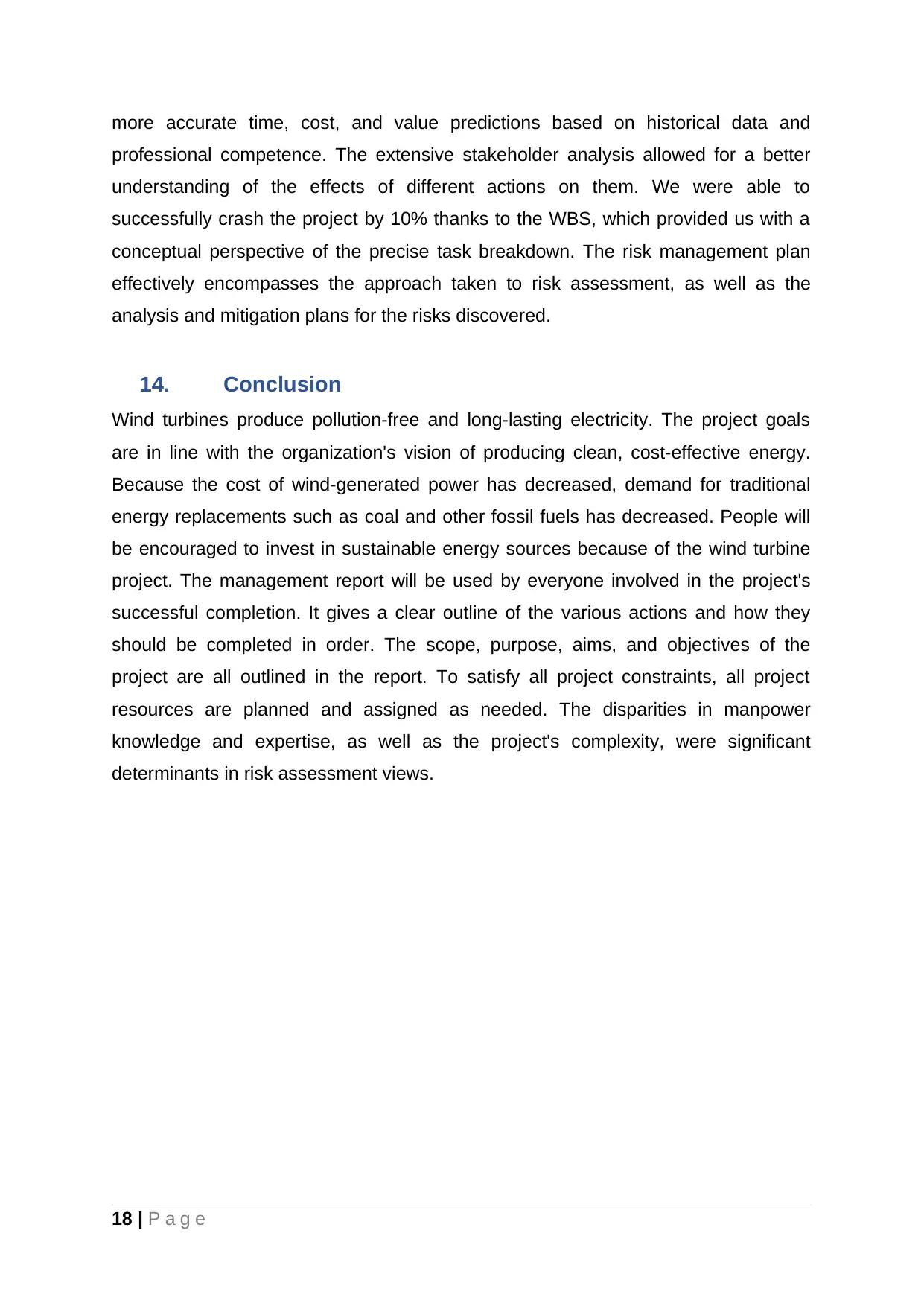
more accurate time, cost, and value predictions based on historical data and
professional competence. The extensive stakeholder analysis allowed for a better
understanding of the effects of different actions on them. We were able to
successfully crash the project by 10% thanks to the WBS, which provided us with a
conceptual perspective of the precise task breakdown. The risk management plan
effectively encompasses the approach taken to risk assessment, as well as the
analysis and mitigation plans for the risks discovered.
14. Conclusion
Wind turbines produce pollution-free and long-lasting electricity. The project goals
are in line with the organization's vision of producing clean, cost-effective energy.
Because the cost of wind-generated power has decreased, demand for traditional
energy replacements such as coal and other fossil fuels has decreased. People will
be encouraged to invest in sustainable energy sources because of the wind turbine
project. The management report will be used by everyone involved in the project's
successful completion. It gives a clear outline of the various actions and how they
should be completed in order. The scope, purpose, aims, and objectives of the
project are all outlined in the report. To satisfy all project constraints, all project
resources are planned and assigned as needed. The disparities in manpower
knowledge and expertise, as well as the project's complexity, were significant
determinants in risk assessment views.
18 | P a g e
professional competence. The extensive stakeholder analysis allowed for a better
understanding of the effects of different actions on them. We were able to
successfully crash the project by 10% thanks to the WBS, which provided us with a
conceptual perspective of the precise task breakdown. The risk management plan
effectively encompasses the approach taken to risk assessment, as well as the
analysis and mitigation plans for the risks discovered.
14. Conclusion
Wind turbines produce pollution-free and long-lasting electricity. The project goals
are in line with the organization's vision of producing clean, cost-effective energy.
Because the cost of wind-generated power has decreased, demand for traditional
energy replacements such as coal and other fossil fuels has decreased. People will
be encouraged to invest in sustainable energy sources because of the wind turbine
project. The management report will be used by everyone involved in the project's
successful completion. It gives a clear outline of the various actions and how they
should be completed in order. The scope, purpose, aims, and objectives of the
project are all outlined in the report. To satisfy all project constraints, all project
resources are planned and assigned as needed. The disparities in manpower
knowledge and expertise, as well as the project's complexity, were significant
determinants in risk assessment views.
18 | P a g e
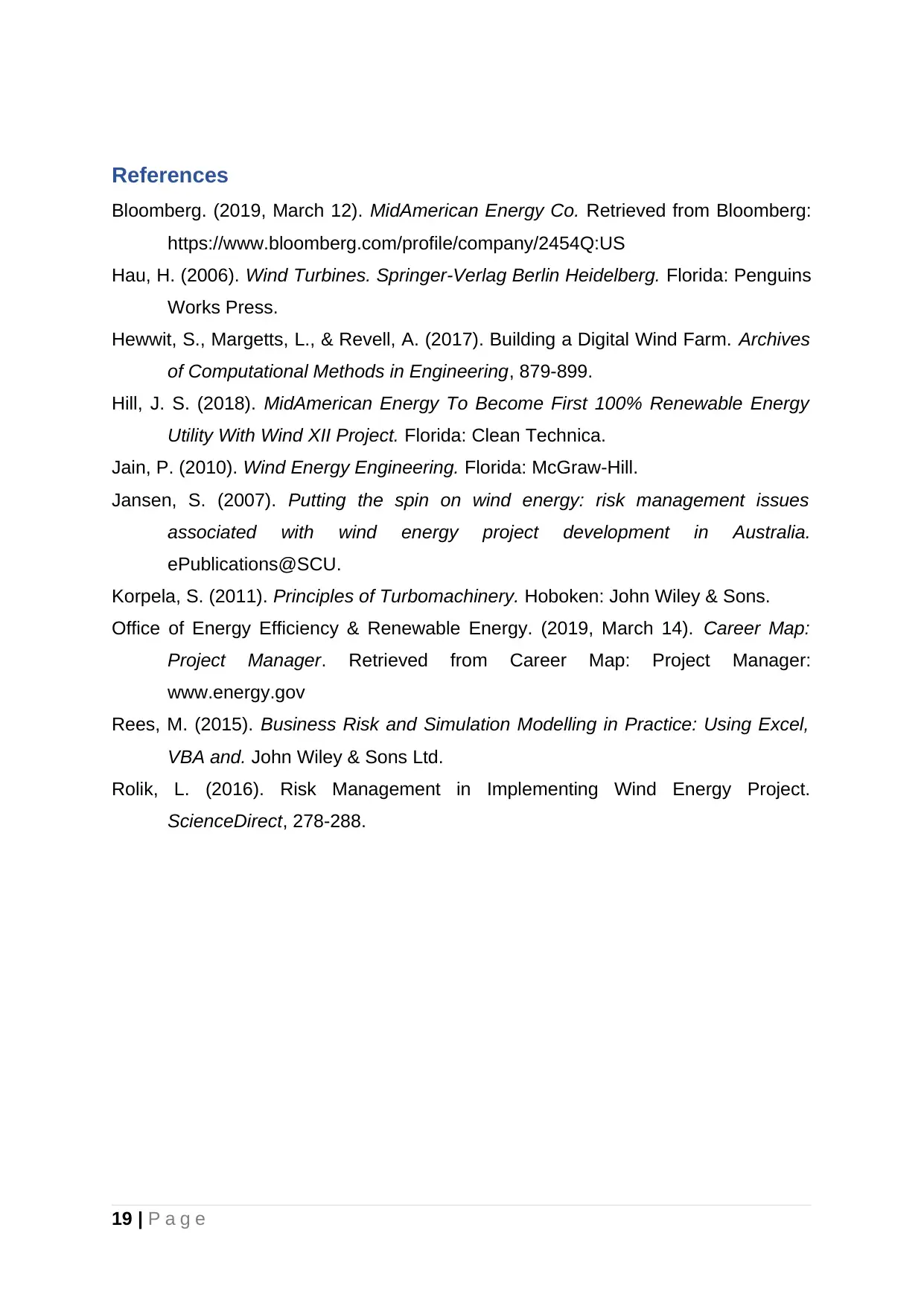
References
Bloomberg. (2019, March 12). MidAmerican Energy Co. Retrieved from Bloomberg:
https://www.bloomberg.com/profile/company/2454Q:US
Hau, H. (2006). Wind Turbines. Springer-Verlag Berlin Heidelberg. Florida: Penguins
Works Press.
Hewwit, S., Margetts, L., & Revell, A. (2017). Building a Digital Wind Farm. Archives
of Computational Methods in Engineering, 879-899.
Hill, J. S. (2018). MidAmerican Energy To Become First 100% Renewable Energy
Utility With Wind XII Project. Florida: Clean Technica.
Jain, P. (2010). Wind Energy Engineering. Florida: McGraw-Hill.
Jansen, S. (2007). Putting the spin on wind energy: risk management issues
associated with wind energy project development in Australia.
ePublications@SCU.
Korpela, S. (2011). Principles of Turbomachinery. Hoboken: John Wiley & Sons.
Office of Energy Efficiency & Renewable Energy. (2019, March 14). Career Map:
Project Manager. Retrieved from Career Map: Project Manager:
www.energy.gov
Rees, M. (2015). Business Risk and Simulation Modelling in Practice: Using Excel,
VBA and. John Wiley & Sons Ltd.
Rolik, L. (2016). Risk Management in Implementing Wind Energy Project.
ScienceDirect, 278-288.
19 | P a g e
Bloomberg. (2019, March 12). MidAmerican Energy Co. Retrieved from Bloomberg:
https://www.bloomberg.com/profile/company/2454Q:US
Hau, H. (2006). Wind Turbines. Springer-Verlag Berlin Heidelberg. Florida: Penguins
Works Press.
Hewwit, S., Margetts, L., & Revell, A. (2017). Building a Digital Wind Farm. Archives
of Computational Methods in Engineering, 879-899.
Hill, J. S. (2018). MidAmerican Energy To Become First 100% Renewable Energy
Utility With Wind XII Project. Florida: Clean Technica.
Jain, P. (2010). Wind Energy Engineering. Florida: McGraw-Hill.
Jansen, S. (2007). Putting the spin on wind energy: risk management issues
associated with wind energy project development in Australia.
ePublications@SCU.
Korpela, S. (2011). Principles of Turbomachinery. Hoboken: John Wiley & Sons.
Office of Energy Efficiency & Renewable Energy. (2019, March 14). Career Map:
Project Manager. Retrieved from Career Map: Project Manager:
www.energy.gov
Rees, M. (2015). Business Risk and Simulation Modelling in Practice: Using Excel,
VBA and. John Wiley & Sons Ltd.
Rolik, L. (2016). Risk Management in Implementing Wind Energy Project.
ScienceDirect, 278-288.
19 | P a g e
1 out of 19
Related Documents
Your All-in-One AI-Powered Toolkit for Academic Success.
+13062052269
info@desklib.com
Available 24*7 on WhatsApp / Email
![[object Object]](/_next/static/media/star-bottom.7253800d.svg)
Unlock your academic potential
© 2024 | Zucol Services PVT LTD | All rights reserved.



